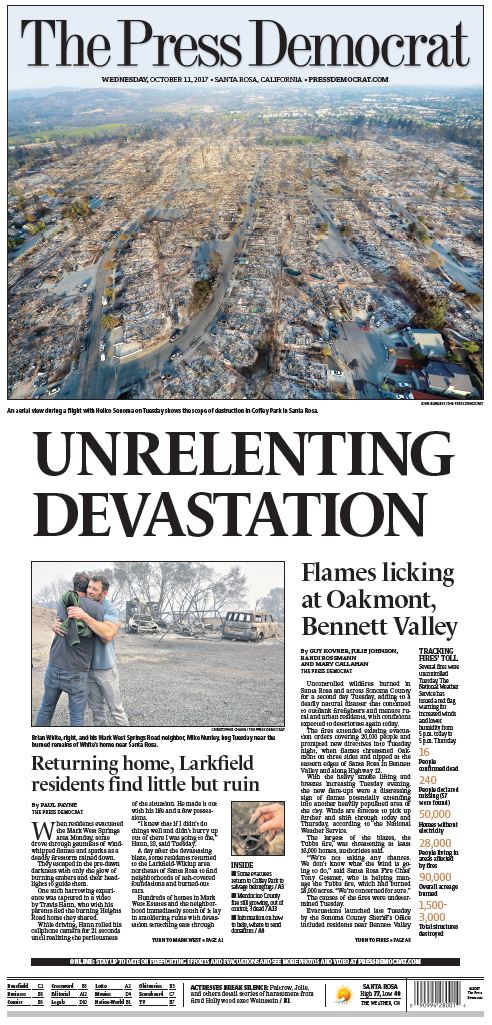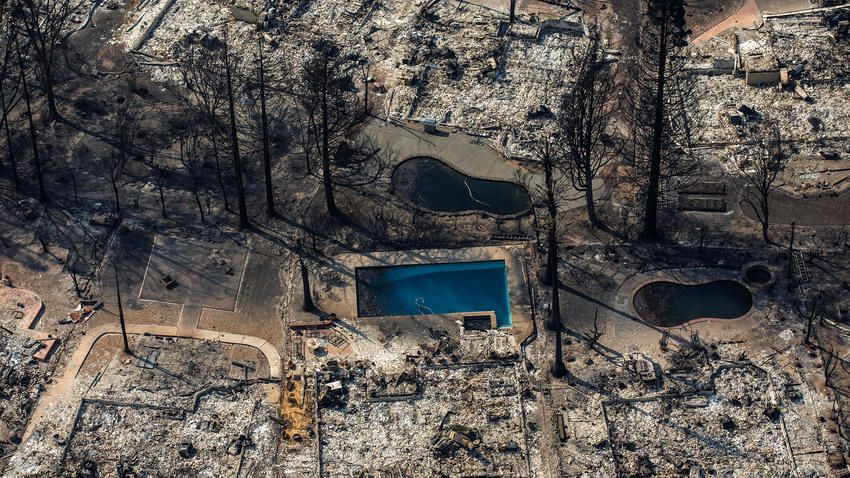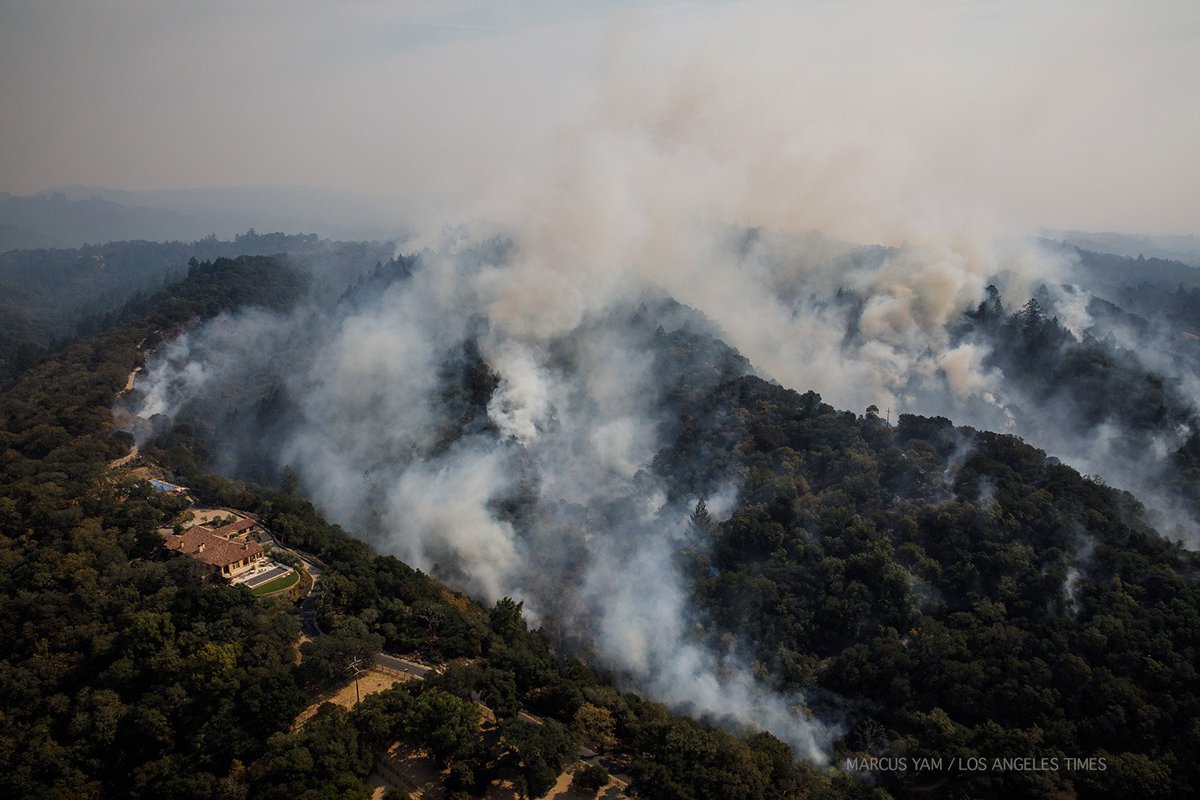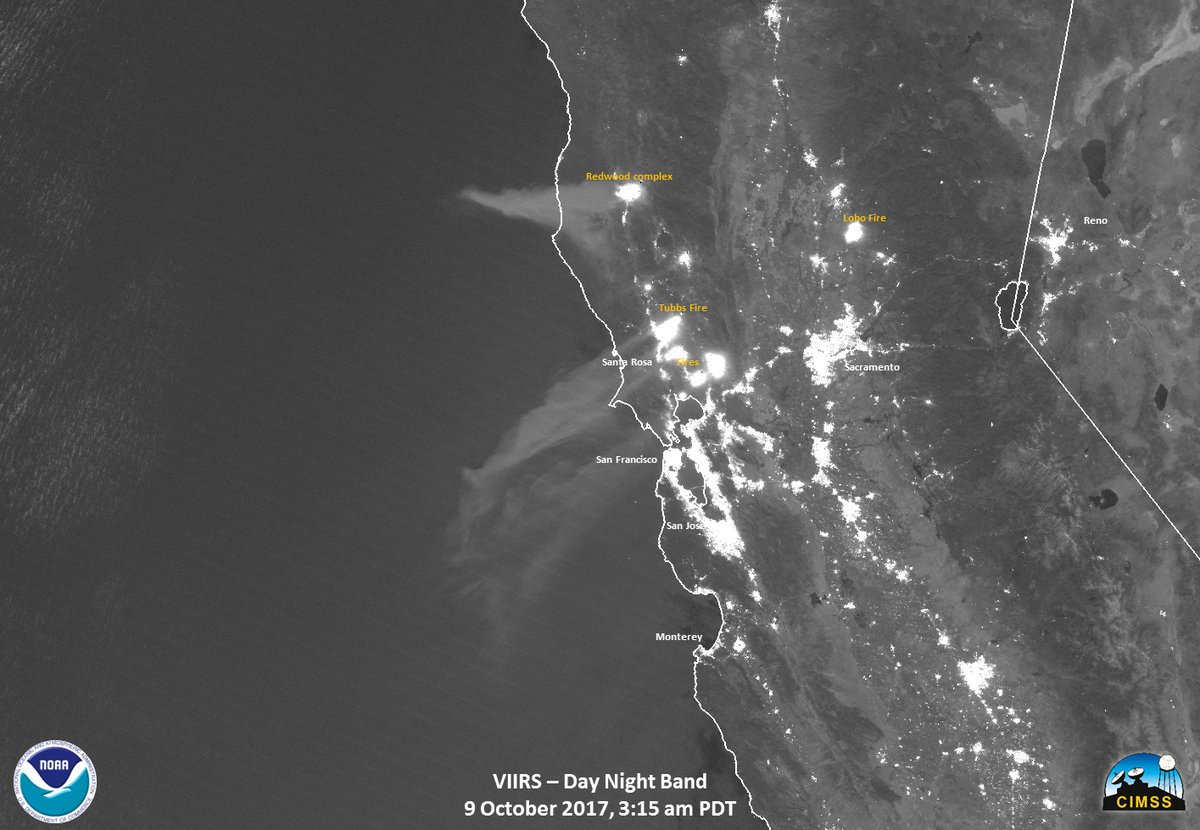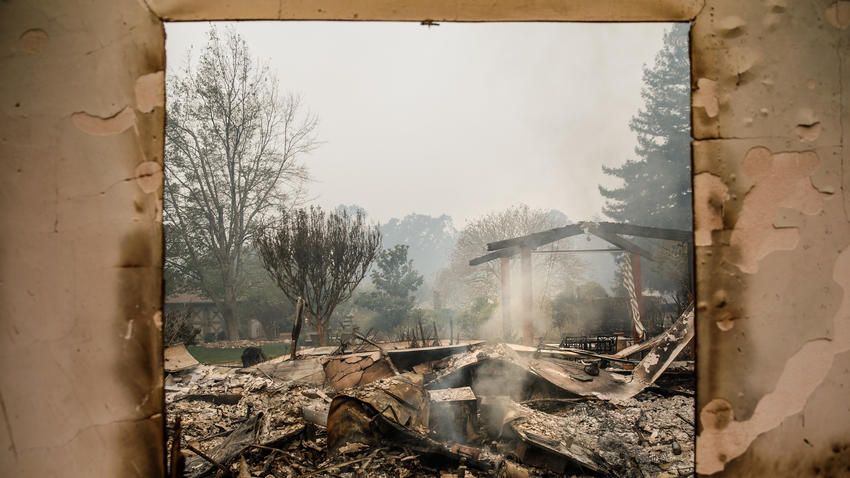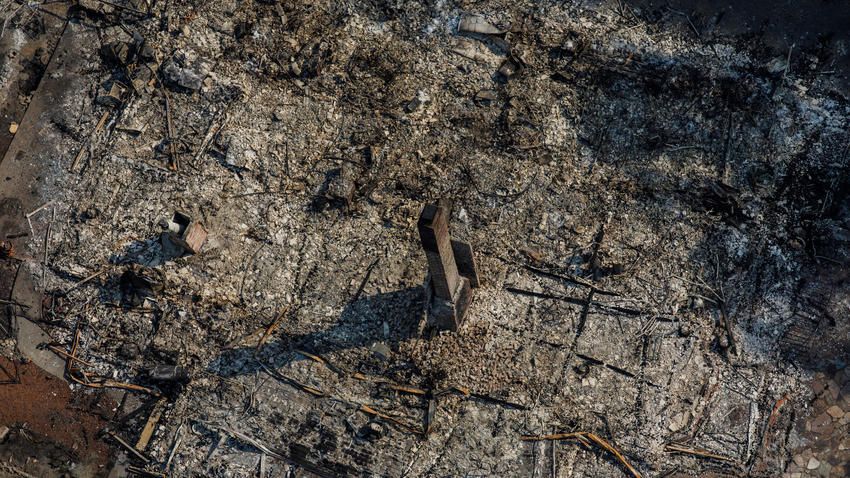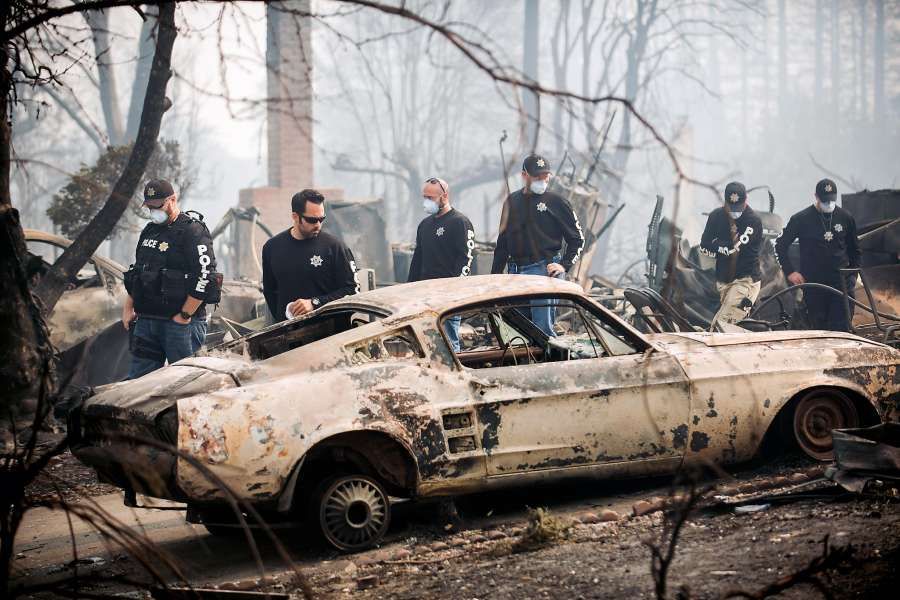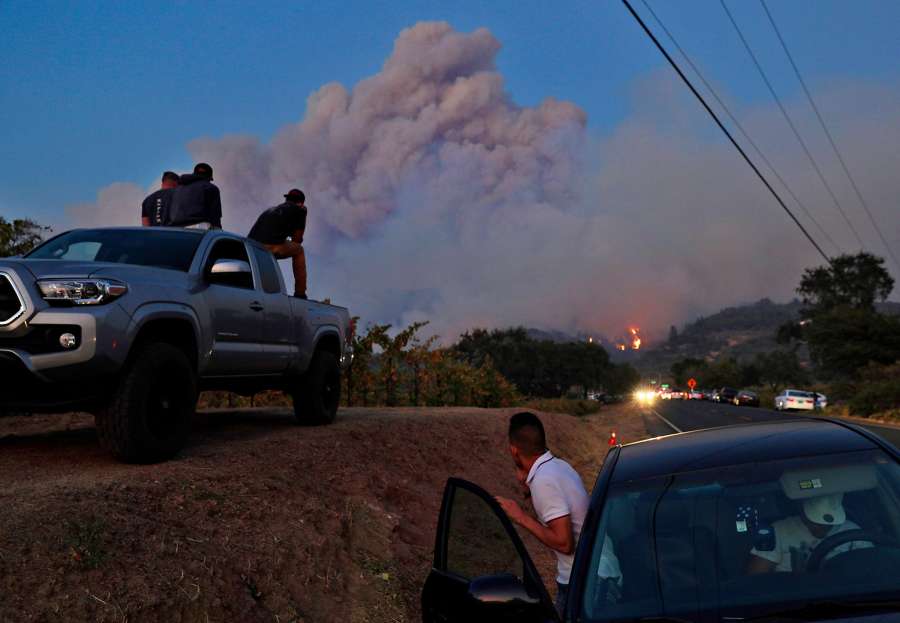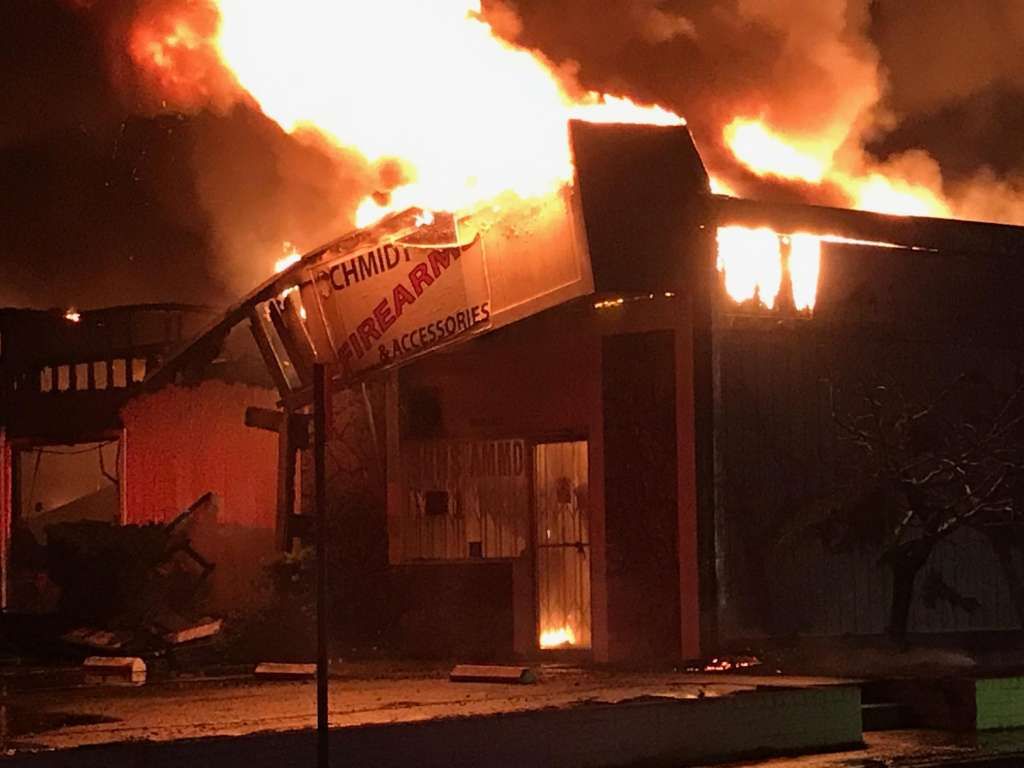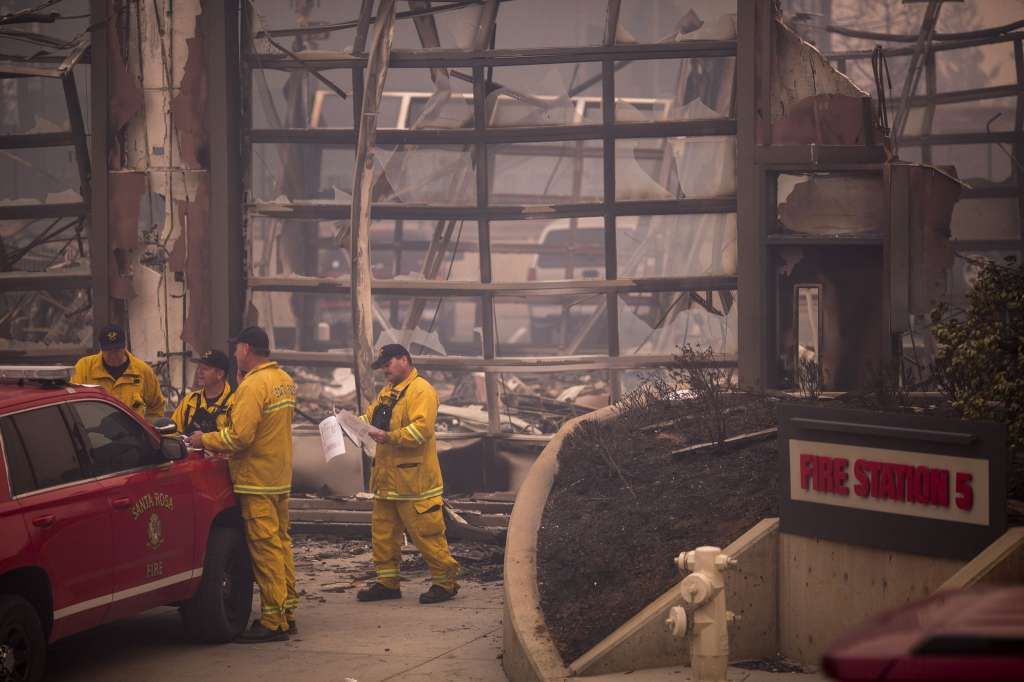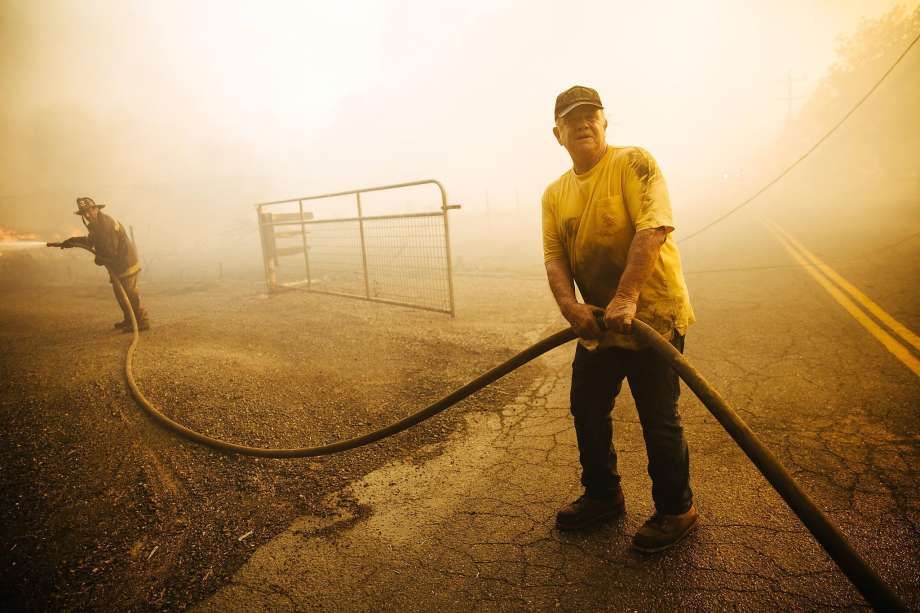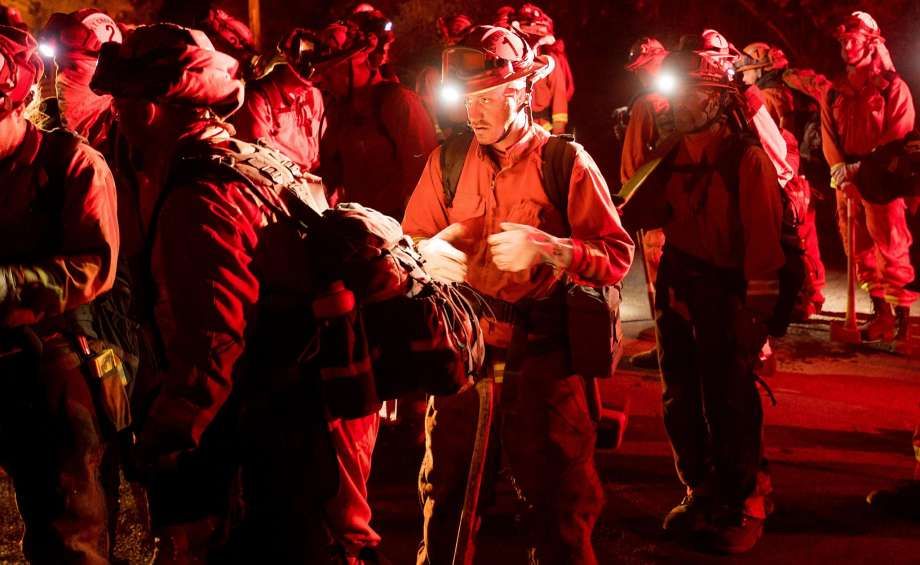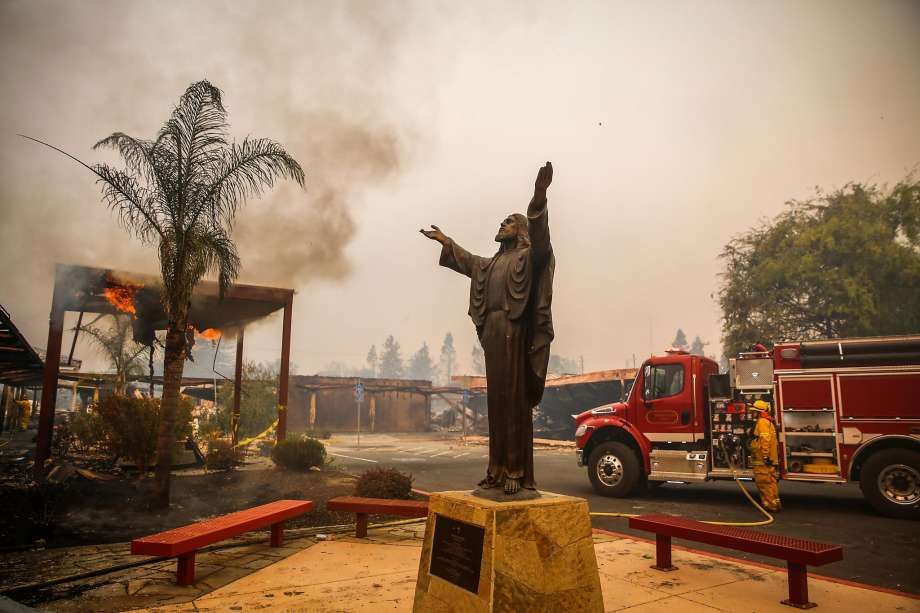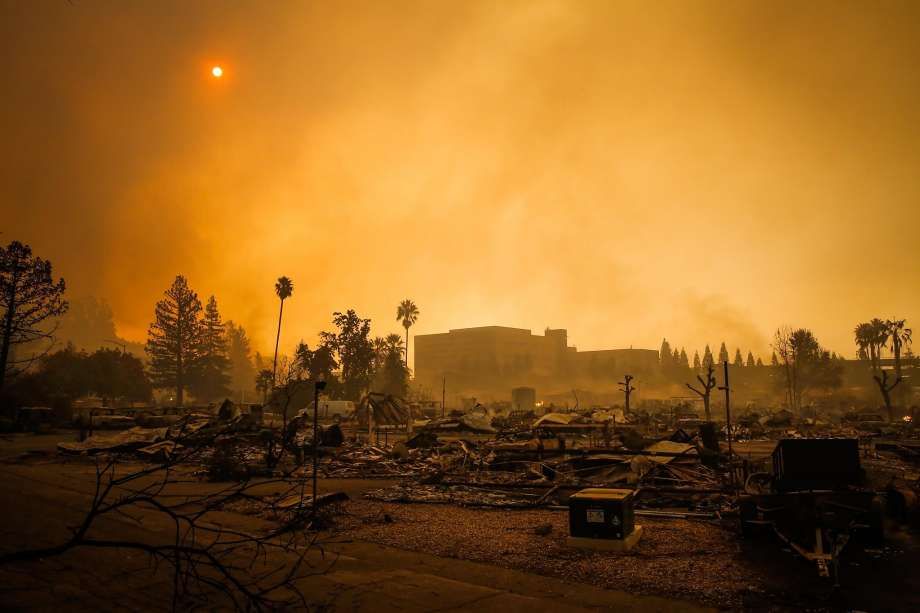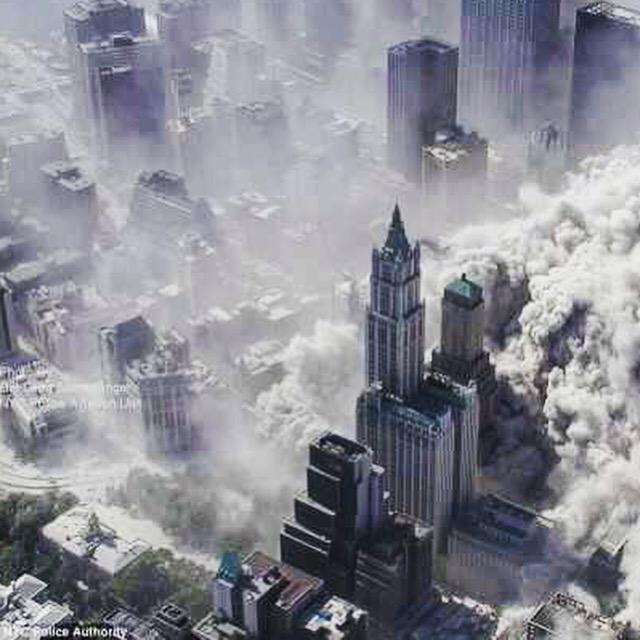. ![]()
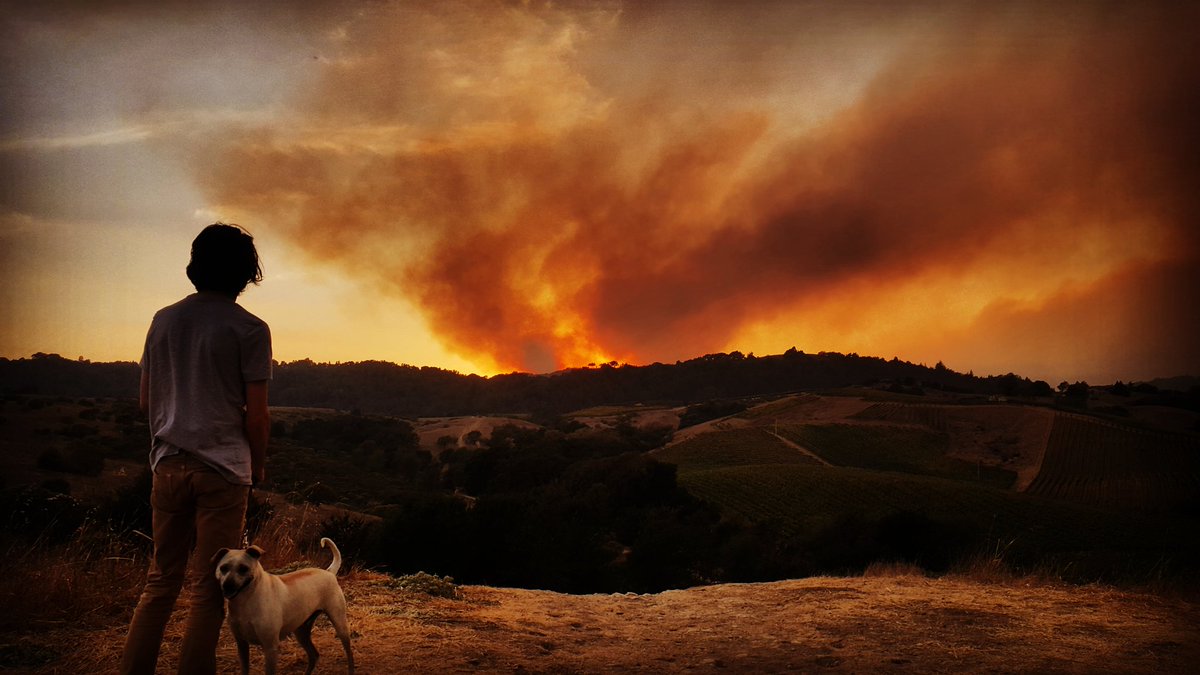
Watching. #winecountryfires #napafires #NorthBayFires: image via Derek Moore @deadlinederek, 10 October 2017

Day 4 begins. Wine Country fires. #napafires #smoke: image via Karl Mondon @karlmondon, 12 October 2017
Not much of a sunrise this a. m. over smokey Santa Rosa: image via Ken McCallum @SRCityBeat, 10 October 2017
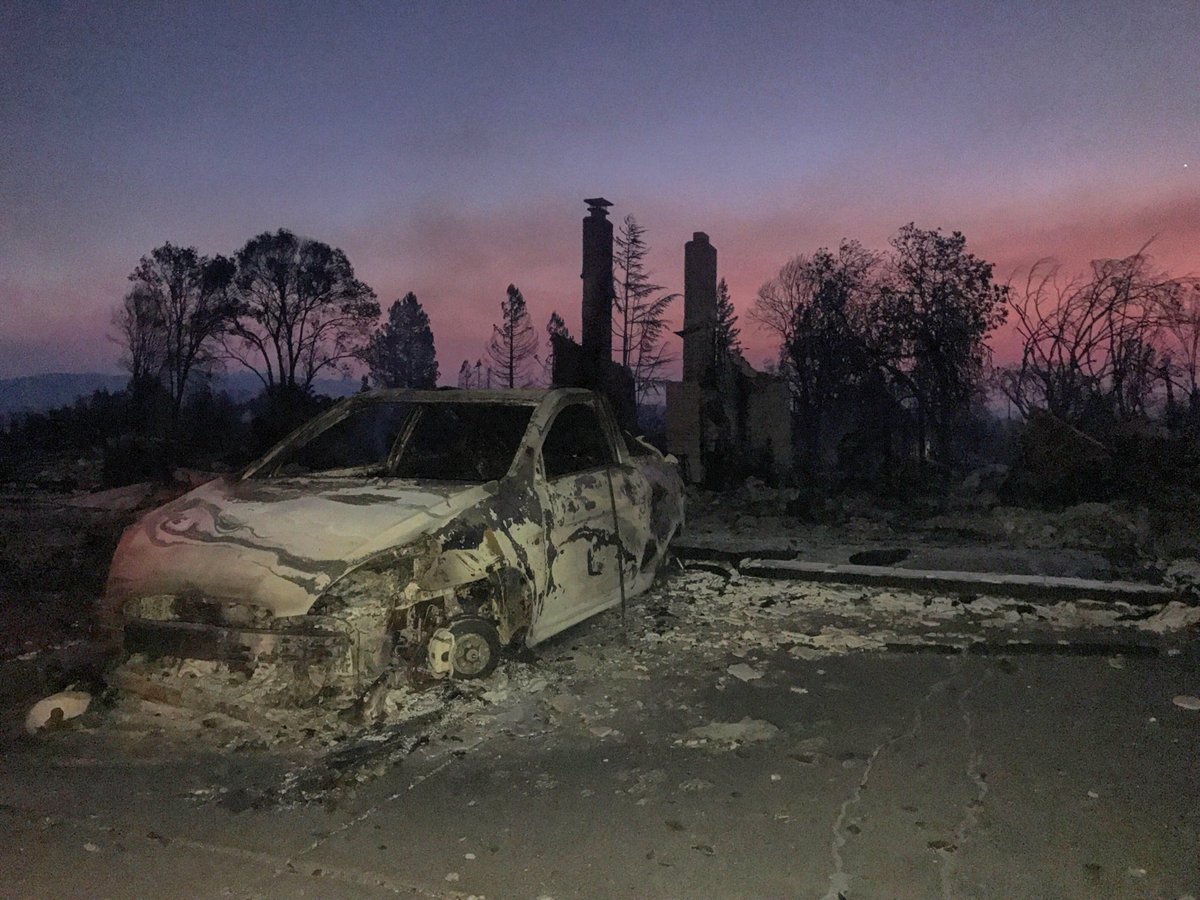
Smoke-filled morning skies highlight devastation in #SantaRosa, CA’s #CoffeyPark neighborhood. Death toll and number of missing is rising.– at Coffey Park: image via Justin Michaels @JMichaelsNews, 12 October 2017
#NorthernLNUCompex, Larkfield/Wikiup,the origin of #TubbsFire, Coffey Park and #Fountaingrove on Wednesday. @NorthBayNews @SantaRosaFire: image via Kent Porter @kentphotos, 11 October 2017
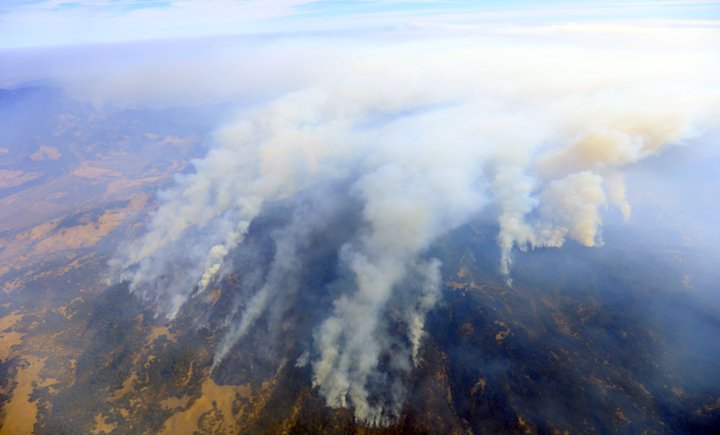
#NorthernLNUCompex, Larkfield/Wikiup, the origin of #TubbsFire, Coffey Park and #Fountaingrove on Wednesday. @NorthBayNews @SantaRosaFire: image via Kent Porter @kentphotos, 11 October 2017
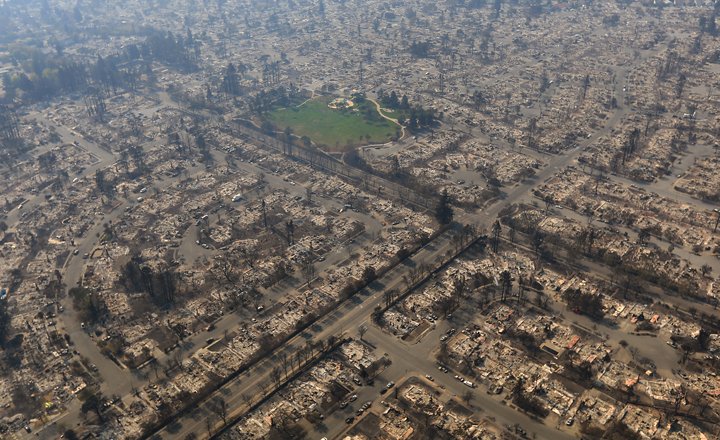
#NorthernLNUCompex, Larkfield/Wikiup, the origin of #TubbsFire, Coffey Park and #Fountaingrove on Wednesday. @NorthBayNews @SantaRosaFire: image via Kent Porter @kentphotos, 11 October 2017
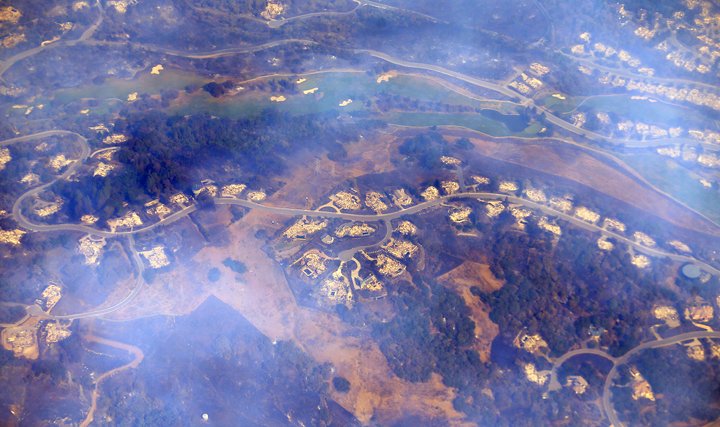
#NorthernLNUCompex, Larkfield/Wikiup, the origin of #TubbsFire, Coffey Park and #Fountaingrove on Wednesday. @NorthBayNews @SantaRosaFire: image via Kent Porter @kentphotos, 11 October 2017
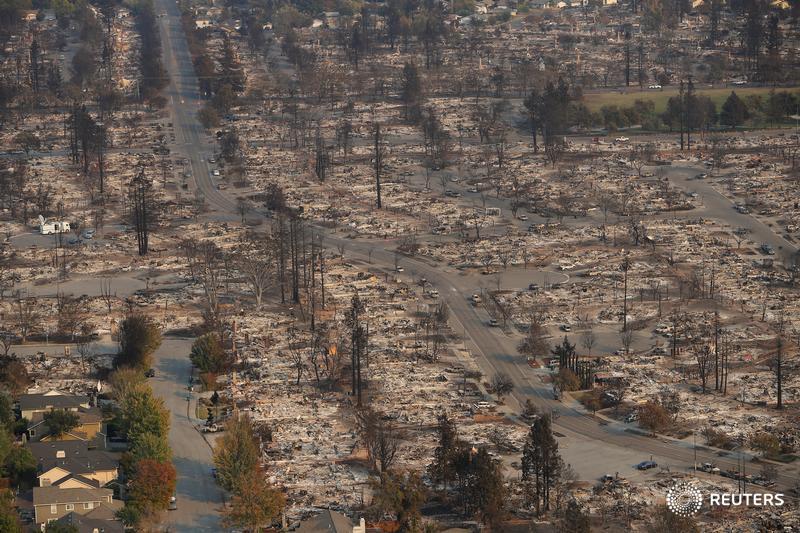
Aerial views of destruction caused by the Tubbs Fire in Santa Rosa, California Photo Stephen Lam: image via Reuters Pictures @reuters pictures, 12 October 2017
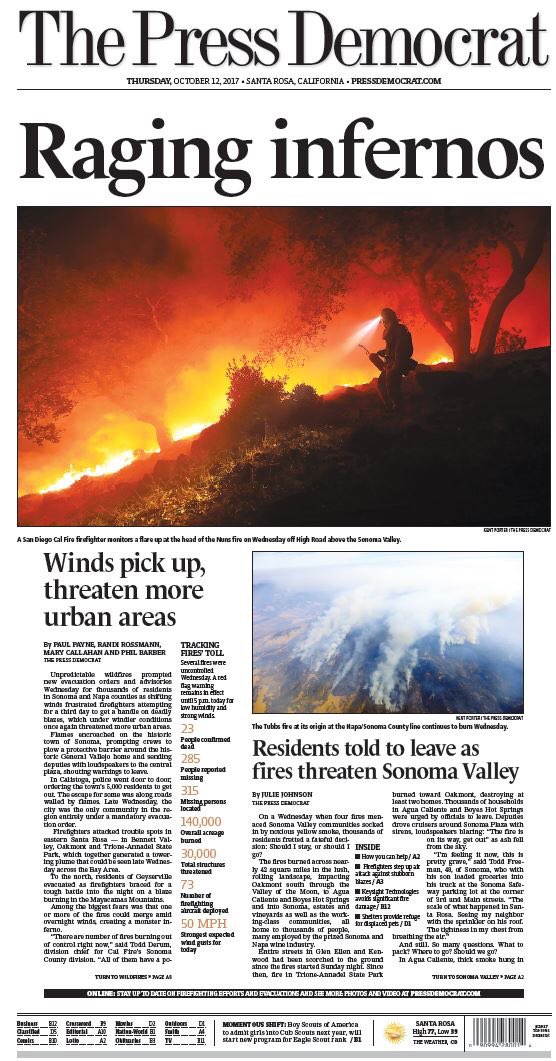
Today's front page @NorthBayNews. Support local journalism. #SouthernLNUComplex @wildfiretoday #northerncaliforniafires #cawx: image via Kent Porter @kentphotos, 12 October 2017
Monday vs Wednesday #lakewildwood #LoboFire #lobofire #McCourtneyFire #WindComplex #NevCo: image vuia Melanie Blair @themelanieblair, 12 October 2017
Shorty
Haven't been able to breathe for days
months maybe years
the stairs seem to go on forever

DSCO426 [Paris]: photo by Pierre Wayser, 1 December 2015
Too Sensitive for Tinseltown: Walter Benjamin: A Map of Hell (1938)

Hollywood is the shame of this country.: image via Shane Bauer @shane_bauer, 19 September 2017
March 6. On recent nightsI've had dreams that remained deeply engraved in my day. Last night I dreamed I had company. Friendly things came my way; I believe they consisted primarily in women taking an interest in me -- indeed, even commenting favorably upon my appearance. I think I remember remarking aloud that now I probably wouldn't live much longer -- as if this were the last display of friendship among people bidding one another farewell.
![File:Enamel setting MNMA Cl23411d.jpg]()
Plique-à-jour enamel setting, cloisonné enamel on gold: Guillaume Julien [?], Paris, late 13th/early 14th century: Musée National du Moyen Age, Paris (image by Jastrow, 2006)
The rooms were on the ground floor facing the street, from which one could look in through a large windowpane. I was on the inside. My lady had obviously already treated her teeth according to the technique that the exhibition was advertising.
![Datei:Blender3D Zahnpastatube.jpg]()
Toothpaste with wood-texturing: Blender3D image by SoylentGreen, 2006
I've been suffering greatly from the noise in my room.
Last night my dream recorded this.
I found myself standing in front of a map and, simultaneously, standing in the landscape which it depicted. The landscape was terrifyingly dreary and bare; I couldn't have said whether its desolation was that of a rocky wasteland or that on an empty ground populated only by capital letters. These letters writhed and curved upon their terrain as if following mountain ranges; I knew or learned that I was in the labyrinth of my auditory canal. But the map was, at the same time, a map of hell.

Plique-à-jour enamel setting, cloisonné enamel on gold: Guillaume Julien [?], Paris, late 13th/early 14th century: Musée National du Moyen Age, Paris (image by Jastrow, 2006)
Later, just before I awoke, I was in the company of a lady in Adrienne Monnier's rooms. They were the setting for an exhibition of objects which I can't quite recall. Among them were books with miniatures, as well as plates and intricately wrought arabesques which were colorfully overlaid as if with enamel.
The rooms were on the ground floor facing the street, from which one could look in through a large windowpane. I was on the inside. My lady had obviously already treated her teeth according to the technique that the exhibition was advertising.
She had polished them to an opalescent shine. The color of her teeth ran to dull green and blue. I took pains to make her understand most politely that this was not the correct use of the product. Anticipating my thoughts, she pointed out that the inner surfaces of her teeth were inlaid in red. I had indeed meant to say that, for teeth, the brightest colors are scarcely bright enough.

Toothpaste with wood-texturing: Blender3D image by SoylentGreen, 2006
Wood-Texture, Band type: Blender3D image by SoylentGreen, 2006
Last night my dream recorded this.
Looping Particle Fire: Blender3D image by SoylentGreen, 2006
I found myself standing in front of a map and, simultaneously, standing in the landscape which it depicted. The landscape was terrifyingly dreary and bare; I couldn't have said whether its desolation was that of a rocky wasteland or that on an empty ground populated only by capital letters. These letters writhed and curved upon their terrain as if following mountain ranges; I knew or learned that I was in the labyrinth of my auditory canal. But the map was, at the same time, a map of hell.
WalterBenjamin (1892-1940): Diary Entries, 1938 (excerpt), translated by Gerhard Richter and Michael W. Jennings in Selected Writings, Volume 3 (1935-1938), 2002
![]()
![]()
As the so-called "Canyon No. 2 fire" raged over the Anaheim Hills, it caused eerie sights over Disneyland, with smokey skies cast in an orange hue.: photo by Bravo, 10 October 2017
![]()
One of the best. #johnwayne #hollywood #hollywoodwalkoffame #california #star #hollywoodboulevard: image via John Wayne Official @JohnDukeWayne, 12 October 2017
![]()
![Lady in evening light, Moscow | by juliehrudova]()
Lady in evening light, Moscow: photo by Julie Hrudova, 23 January 2016
![Circus | by i.am.mine]()
Circus [Palermo]: photo by Giorgio S, 26 January 2017
![Circus | by i.am.mine]()
Circus [Palermo]: photo by Giorgio S, 26 January 2017
![Circus | by i.am.mine]()
Circus [Palermo]: photo by Giorgio S, 26 January 2017 ![]()
#Bangladesh A woman is carried to the shore of the Naf river as hundreds of Rohingya refugees arrive by boat. By @paulaphoto Getty: image via Photojournalism @photojournalink, 8 October 2017
![]()
Monsoon rains cause more chaos as Rohingya scramble for aid by a local organization in a overcrowded muddy refugee camp. #rohingya: image via Paula Bronstein @paulaphoto, 7 October 2017
![]()
#Bangladesh #RohingyaCrisis "School a rare sanctuary for traumatised Rohingya children"#AFP photo @thisisindra: image via Aurelia BAILLY @AureliaBAILLY, 11 October 2017
![]()
#Bangladesh #RohingyaCrisis Refugees take shelter in the shadow at the Palangkhali refugee camp in Ukhia district. Photo @thisisindra: image via Aurelia BAILLY @AureliaBAILLY, 11 October 2017
![]()
#Bangladesh #RohingyaCrisis Refugees take shelter in the shadow at the Palangkhali refugee camp in Ukhia district. Photo @thisisindra: image via Aurelia BAILLY @AureliaBAILLY, 11 October 2017
![]()
#Bangladesh #RohingyaCrisis "In the chaos of Bangladesh's refugee camps, a baby is born" #AFP photo @uz_munir: image via Aurelia BAILLY @AureliaBAILLY, 12 October 2017
![]()
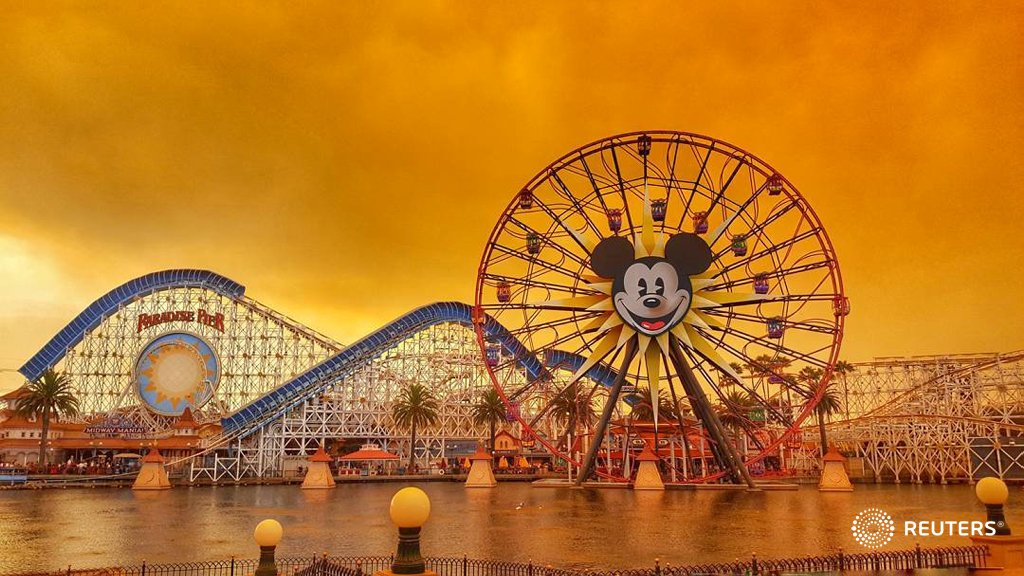
Smoke and flames turn the skies above Disneyland yellow in Anaheim, as deadly wildfires sweep through California: image via Reuters Pictures @reuterspictures, 11 October 2017

As the so-called "Canyon No. 2 fire" raged over the Anaheim Hills, it caused eerie sights over Disneyland, with smokey skies cast in an orange hue.: photo by Bravo, 10 October 2017
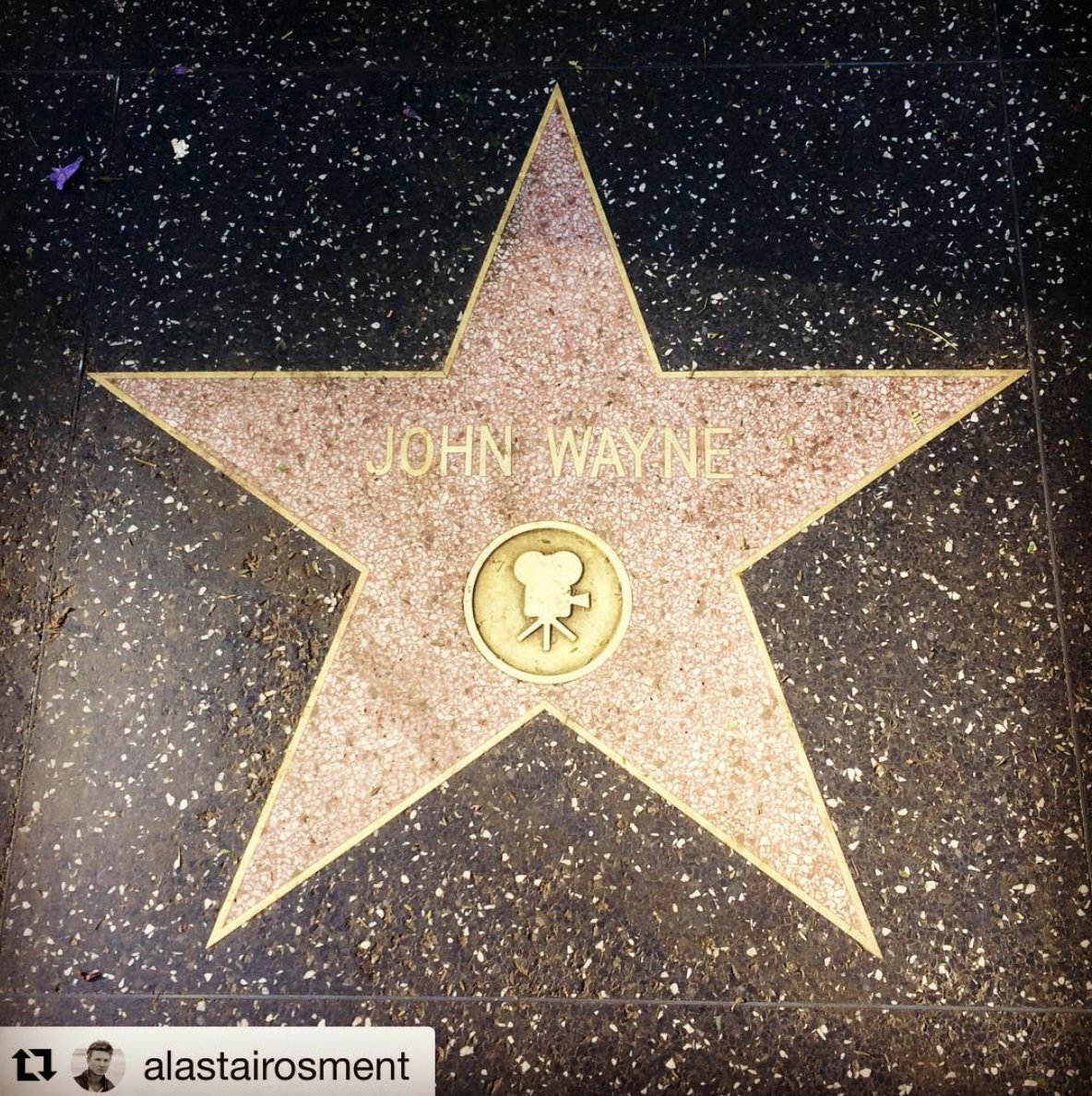
One of the best. #johnwayne #hollywood #hollywoodwalkoffame #california #star #hollywoodboulevard: image via John Wayne Official @JohnDukeWayne, 12 October 2017
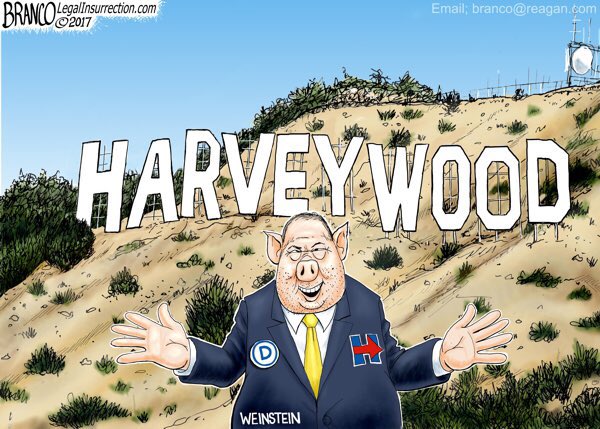
“Abandon hope all ye who enter here” #HarveyWeinstein: image via Larry Elder @larryelder, 12 October 2017
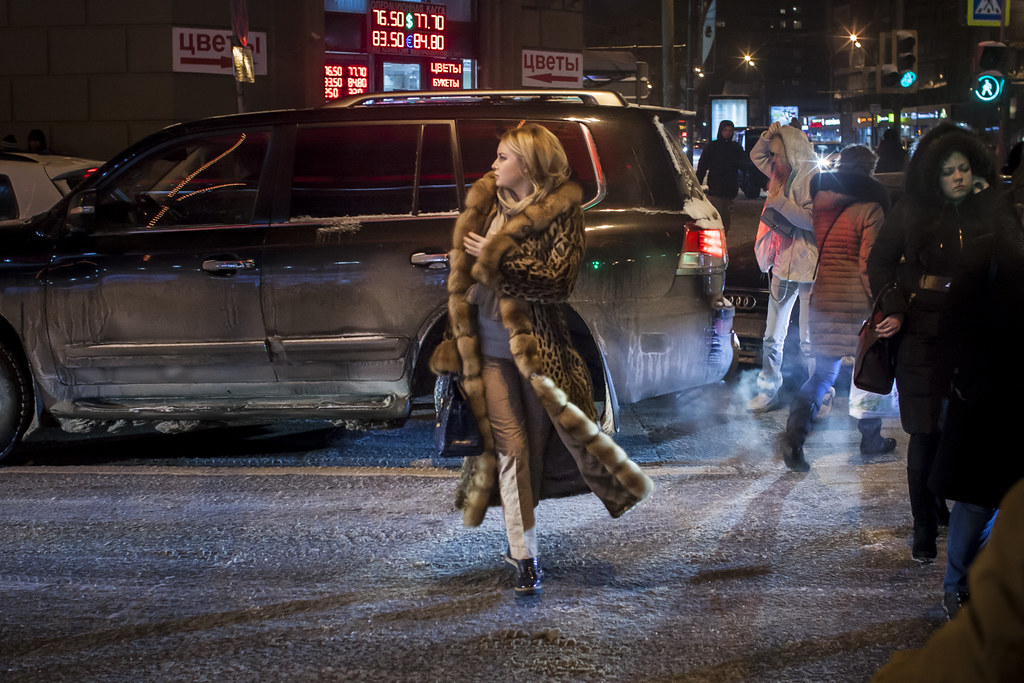
Lady in evening light, Moscow: photo by Julie Hrudova, 23 January 2016
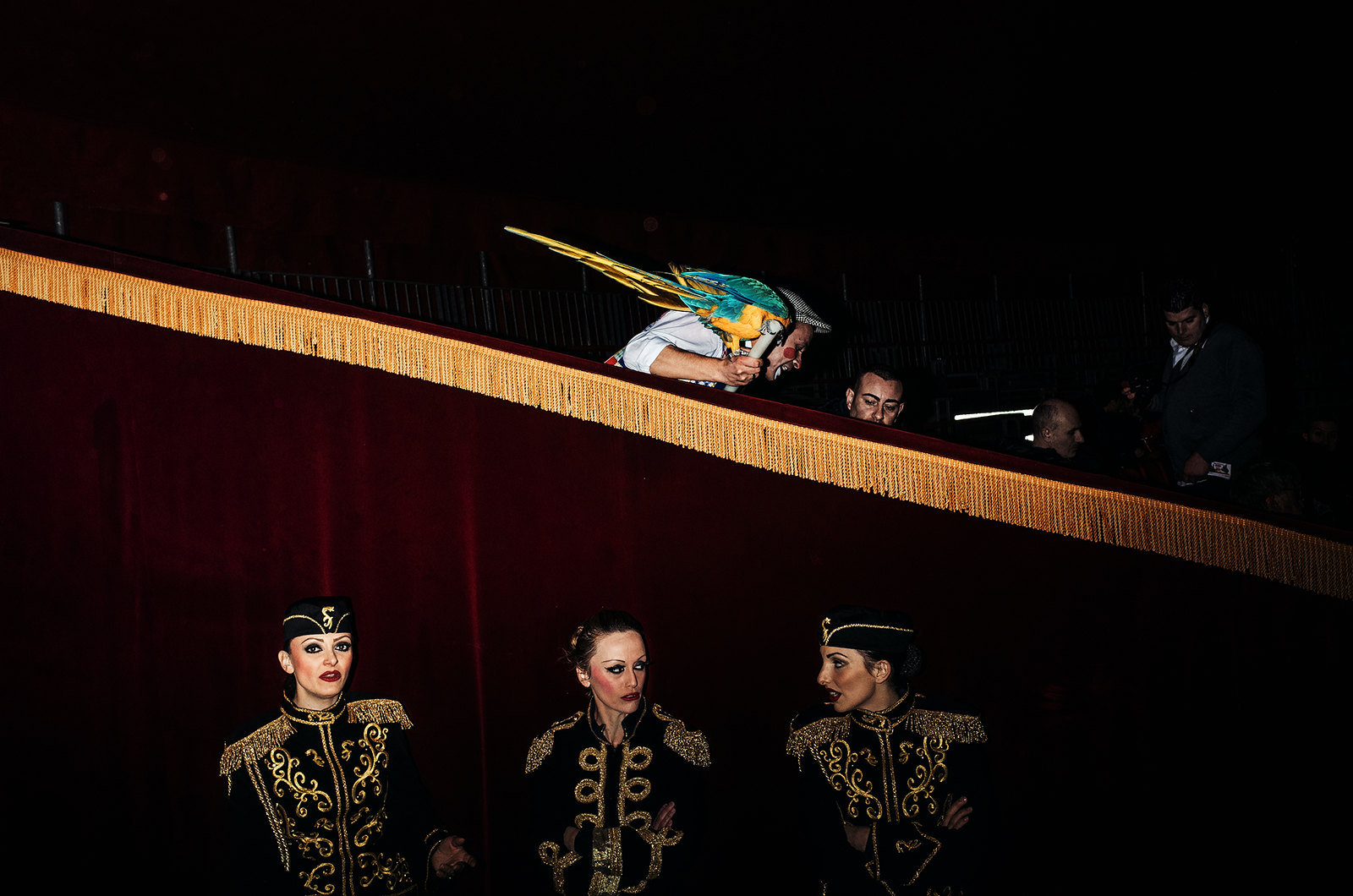
Circus [Palermo]: photo by Giorgio S, 26 January 2017

Circus [Palermo]: photo by Giorgio S, 26 January 2017

Circus [Palermo]: photo by Giorgio S, 26 January 2017

#Bangladesh A woman is carried to the shore of the Naf river as hundreds of Rohingya refugees arrive by boat. By @paulaphoto Getty: image via Photojournalism @photojournalink, 8 October 2017
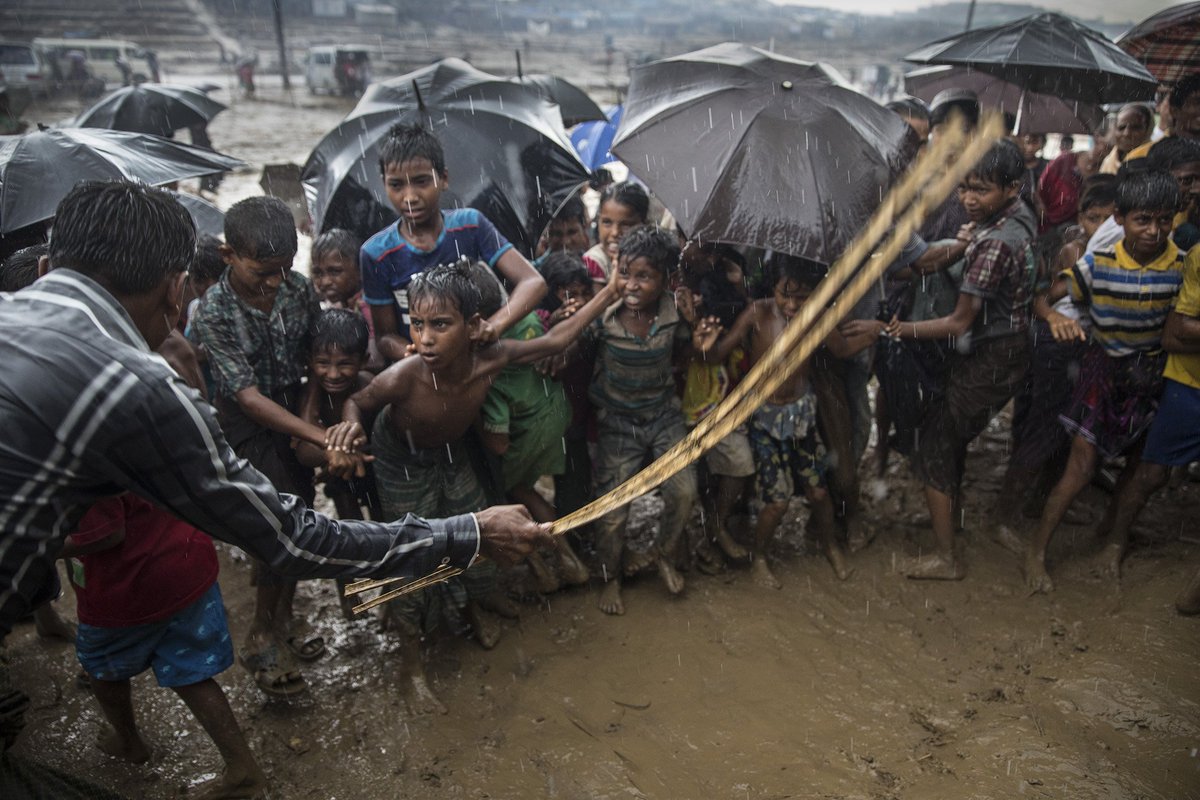
Monsoon rains cause more chaos as Rohingya scramble for aid by a local organization in a overcrowded muddy refugee camp. #rohingya: image via Paula Bronstein @paulaphoto, 7 October 2017
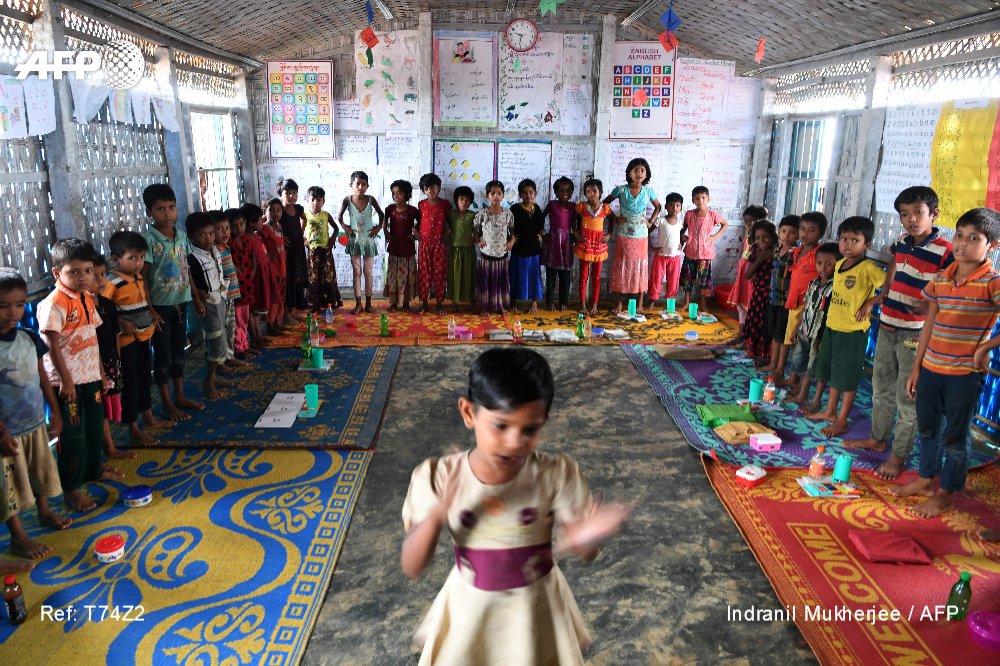
#Bangladesh #RohingyaCrisis "School a rare sanctuary for traumatised Rohingya children"#AFP photo @thisisindra: image via Aurelia BAILLY @AureliaBAILLY, 11 October 2017
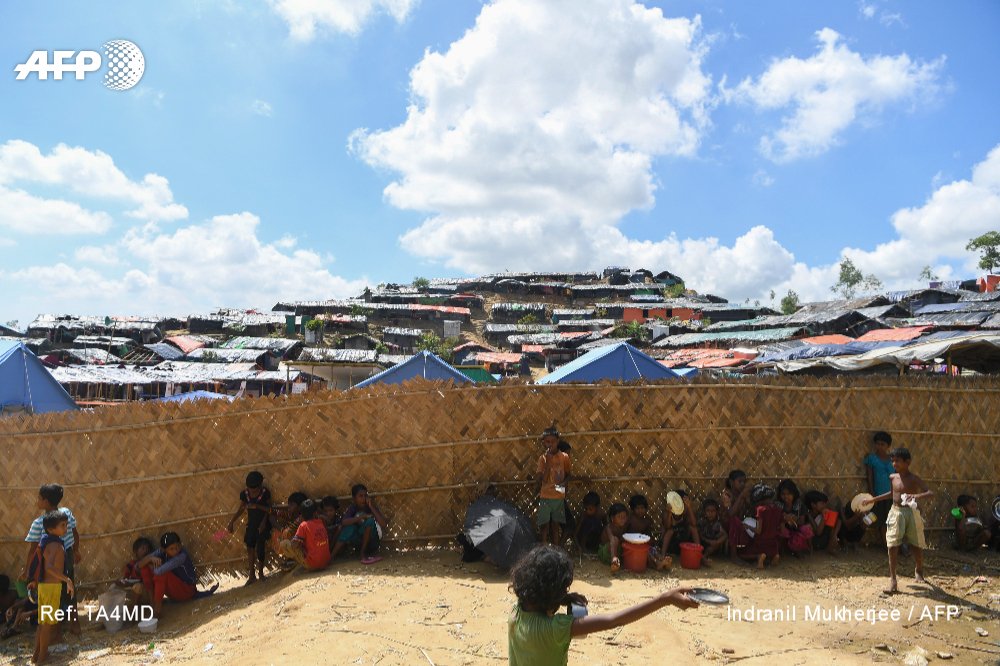
#Bangladesh #RohingyaCrisis Refugees take shelter in the shadow at the Palangkhali refugee camp in Ukhia district. Photo @thisisindra: image via Aurelia BAILLY @AureliaBAILLY, 11 October 2017
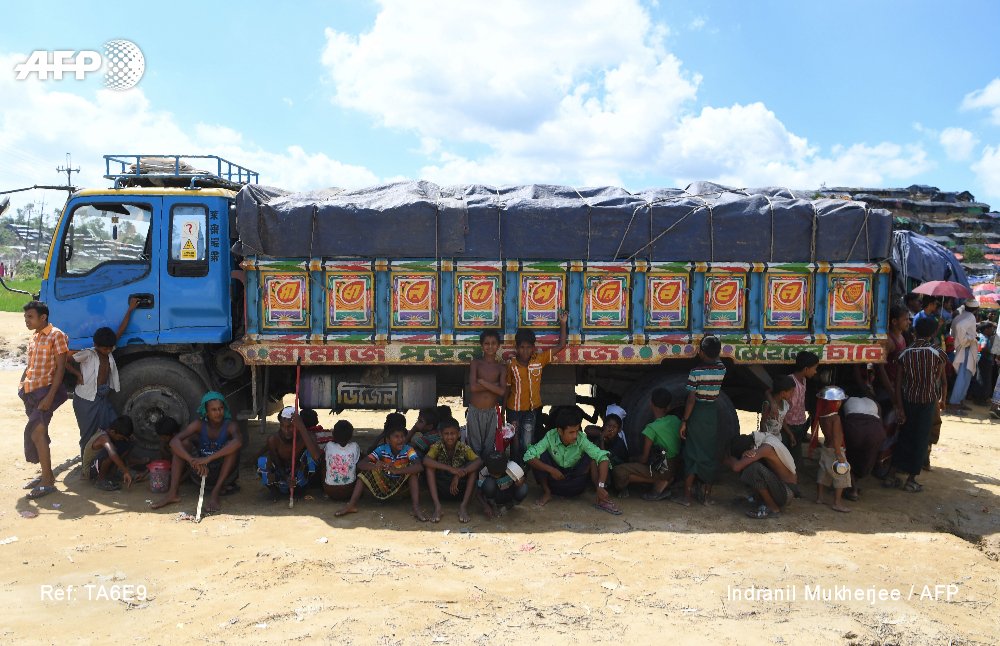
#Bangladesh #RohingyaCrisis Refugees take shelter in the shadow at the Palangkhali refugee camp in Ukhia district. Photo @thisisindra: image via Aurelia BAILLY @AureliaBAILLY, 11 October 2017

#Bangladesh #RohingyaCrisis "In the chaos of Bangladesh's refugee camps, a baby is born" #AFP photo @uz_munir: image via Aurelia BAILLY @AureliaBAILLY, 12 October 2017

In this Oct. 2, 2017 photo, newly arrived Rohingya refugee Yosar Hossein, 7, carries his baby sister Noyem Fatima and walks followed by his other siblings and mother Firoza Begum on a mud bank leading to a Bangladesh army run processing center where they will be allotted their camp, in Teknaf, Bangladesh. Barefoot and still wearing his school uniform, the 7-year-old is among more than a half million persecuted Rohingya Muslims fleeing neighboring Myanmar.: photo by Gemunu Amarasinghe/AP, 2 October 2017
A Rohingya boy’s struggle to reach Bangladesh: Gemunu Amarasinghe, AP Photos, 11 October 2017
TEKNAF, Bangladesh (AP) — Yosar Hossein struggles as he walks along muddy paths and flooded creeks in Bangladesh, carrying his baby sister on his back. Barefoot and still wearing his school uniform, the 7-year-old is among more than a half million Rohingya Muslims fleeing violence in neighboring Myanmar.
Nearly two-thirds are children.
“She is very heavy,” says Yosar, who in the last two weeks has lost his father, his house and his country. “I don’t think I can carry her all the way.”
The exodus from predominantly Buddhist Myanmar is the biggest the region has seen in decades, leaving this corner of Bangladesh overrun with tent cities of desperate refugees.
It began Aug. 25, when the military responded to attacks by Rohingya militants with a brutal crackdown on members the Muslim minority. Soldiers and Buddhist mobs started killing, looting and burning down village after village.
Yosar’s mother, Firoza Begum, says their home in Rathedaung township was attacked just before dawn two weeks ago. They heard loud bangs and watched as flames swallowed almost everything they owned.
Yosar’s dad didn’t make it out, Begum says. He was shot dead as they tried to flee. But his mom and three younger siblings managed to escape. They walked for six days, together with two aunts and several cousins, eating whatever they could find, resting very little, until they reached the shore of the mighty Naf River.
They piled into an overcrowded wooden boat and headed to neighboring Bangladesh. But the journey did not end there.
The family continued for another day — on foot, inside rickshaws and on the back of a truck — Yosar still in the green-and-white school clothes he was wearing when he left Myanmar.
“I wore black shoes and black socks, too,” says the second-grader, who misses his school. “But I forgot to bring them when we fled our home.”
Finally, on Oct. 2, Yosar and his family made it to a relative’s house in Bangladesh.
He managed to carry his younger sister all the way.
![None]()
In this Oct. 2, 2017 photo, newly arrived Rohingya refugee Yosar Hossein, 7, carries his baby sister Noyem Fatima and walks past a muddy patch in Teknaf, Bangladesh. Barefoot and still wearing his school uniform, the 7-year-old is among more than a half million persecuted Rohingya Muslims fleeing neighboring Myanmar.: photo by Gemunu Amarasinghe/AP, 2 October 2017
![None]()
In this Oct. 2, 2017 photo, newly arrived Rohingya refugee Yosar Hossein, center, carries his baby sister Noyem Fatima and wait too board a boat to cross a creek leading to a Bangladesh army run processing center where they will be allotted their camp, in Teknaf, Bangladesh. Barefoot and still wearing his school uniform, the 7-year-old is among more than a half million persecuted Rohingya Muslims fleeing neighboring Myanmar. Yosar’s mother, Firoza Begum, says their home in Rathedaung township was attacked just before dawn two weeks ago. Yosar’s dad didn’t make it out.: photo by Gemunu Amarasinghe/AP, 2 October 2017
![None]()
In this Oct. 2, 2017 photo, Foriza Begum holds a fan to shield her son Yosar Hossein, 7, and two-year-old daughter Noyem Fatima, on their way to a Bangladesh army run processing center where they will be allotted their camp, in Teknaf, Bangladesh. Barefoot and still wearing his school uniform, the 7-year-old is among more than a half million persecuted Rohingya Muslims fleeing neighboring Myanmar. Yosar and his family walked for six days, together with two aunts and several cousins, eating whatever they could find, resting very little, until they reached the shore of the mighty Naf River. He managed to carry his younger sister all the way.: photo by Gemunu Amarasinghe/AP, 2 October 2017
![None]()
In this Oct. 2, 2017 photo, newly arrived Rohingya refugee Yosar Hossein, 7, wearing white shirt, travels with his family and other refugees on a boat towards a Bangladesh army run processing center where they will be allotted their camp, in Shah Porir Dwip, Bangladesh. Barefoot and still wearing his school uniform, the 7-year-old is among more than a half million persecuted Rohingya Muslims fleeing neighboring Myanmar.: photo by Gemunu Amarasinghe/AP, 2 October 2017
![None]()
In this Oct. 2, 2017 photo, Firoza Begum narrates the story of her family with her children standing beside her at a Bangladesh army run processing center where they will be allotted their camp, in Teknaf, Bangladesh. Begum says their home in Rathedaung township was attacked just before dawn two weeks ago. They heard loud bangs and watched as flames swallowed almost everything they owned.: photo by Gemunu Amarasinghe/AP, 2 October 2017
![None]()
In this Oct. 2, 2017 photo, two-year old Noyem Fatima offers a piece of banana to her elder brother Yosar Hossein, 7, as they sit on a sidewalk with their belongings in Leda, Bangladesh. Hossein carried his baby sister Noyem for seven days fleeing from their village in Myanmar to a refugee camp in Bangladesh with their mother and other siblings.: photo by Gemunu Amarasinghe/AP, 2 October 2017
![None]()
In this Oct. 2, 2017 photo, Rohingya boy Yosar Hussein, 7, smiles as his mother asks him to return as he takes a quick dip in a creek, during their journey to a Bangladesh army run processing center where they will be allotted their camp, in Teknaf, Bangladesh. Yosar and his family walked for six days, eating whatever they could find, resting very little, until they reached the shore of the mighty Naf River. Here they piled into an overcrowded wooden boat and headed to neighboring Bangladesh. The family continued for another day, on foot, inside rickshaws and on the back of a truck until they made it to a relative’s house in Bangladesh. All the while, Yosar carried his two-year-old sister on his back.: photo by Gemunu Amarasinghe/AP, 2 October 2017
![]()
Rohingya refugees arriving in Bangladesh after crossing the Naf River this month.: photo by Sergey Ponomarev for The New York Times, 12 October 2017
![]()
Rohingya refugees arriving in Bangladesh after crossing the Naf River this month.: photo by Sergey Ponomarev for The New York Times, 12 October 2017
![]()
Hundreds of thousands of Rohingya have fled to rough camps in Bangladesh like this one, Balukhali.: photo by Sergey Ponomarev for The New York Times, 12 October 2017
![]()
Hundreds of thousands of Rohingya have fled to rough camps in Bangladesh like this one, Balukhali.: photo by Sergey Ponomarev for The New York Times, 12 October 2017
![]()
Rohingya women waiting at the World Food Program distribution point in Tchainkali camp, Bangladesh.: photo by Sergey Ponomarev for The New York Times, 12 October 2017
![]()
Rohingya women waiting at the World Food Program distribution point in Tchainkali camp, Bangladesh.: photo by Sergey Ponomarev for The New York Times, 12 October 2017
![]()
Rohingya men praying at a makeshift mosque in the Noapara camp, outside Cox’s Bazar, Bangladesh.: photo by Sergey Ponomarev for The New York Times, 12 October 2017
![]()
Rohingya men praying at a makeshift mosque in the Noapara camp, outside Cox’s Bazar, Bangladesh.: photo by Sergey Ponomarev for The New York Times, 12 October 2017
![]()
Rajuma, 20, saw her 18-month-old son and most of the rest of her family killed by soldiers in Myanmar. She is now in the Kutupalong refugee camp in Bangladesh.: photo by Sergey Ponomarev for The New York Times, 12 October 2017
![]()
Rajuma, 20, saw her 18-month-old son and most of the rest of her family killed by soldiers in Myanmar. She is now in the Kutupalong refugee camp in Bangladesh.: photo by Sergey Ponomarev for The New York Times, 12 October 2017
![]()
A Rohingya family at the newly erected Balukhali camp.: photo by Sergey Ponomarev for The New York Times, 12 October 2017
![]()
A Rohingya family at the newly erected Balukhali camp.: photo by Sergey Ponomarev for The New York Times, 12 October 2017
![]()
A drawing by a Rohingya boy about his experiences while fleeing Myanmar.: photo by Sergey Ponomarev for The New York Times, 12 October 2017
![]()
A drawing by a Rohingya boy about his experiences while fleeing Myanmar.: photo by Sergey Ponomarev for The New York Times, 12 October 2017
![]()
The body of a Rohingya woman washed up in Bangladesh after her boat sank in rough seas in late September.: photo by Sergey Ponomarev for The New York Times, 12 October 2017
![]()
The body of a Rohingya woman washed up in Bangladesh after her boat sank in rough seas in late September.: photo by Sergey Ponomarev for The New York Times, 12 October 2017
![Ship and aurora | by efo]()
![Ship and aurora | by efo]()
![Ship and aurora | by efo]()
![Untitled | by nobruskt]()
Untitled: photo by Bruno Oliveira, 24 September 2017
![Untitled | by nobruskt]()
![Untitled | by nobruskt]()
Untitled: photo by Bruno Oliveira, 24 September 2017
![Nevada | by Missy Prince]()
Nevada: photo by Missy Prince, 3 October 2017
![Untitled | by Missy Prince]()
Keeler, California: photo by Missy Prince, 17 May 2017
![Way out West | by StuConFlo]()
Way out West: photo by StuConFlo, 12 October 2017
![Decomposition | by ADMurr]()
Composition [Santa Barbara County]: photo by Andrew Murr, 11 October 2017
![2017-203 | by biosfear]()
2017-203. Weed, CA: photo by biosfear, 11 October 2017
![Land of the free | by radargeek]()
Land of the free [El Reno, OK]: photo by Justin Waits, 15 October 2017
![Land of the free | by radargeek]()
Land of the free [El Reno, OK]: photo by Justin Waits, 15 October 2017
![Land of the free | by radargeek]()
Land of the free [El Reno, OK]: photo by Justin Waits, 15 October 2017
![]()
World Trade Center Towers, New York. In the decade since, most people absorbed 9/11 and moved on, but there are lingering wisps of its effects everywhere.: photo by Katie Day Weisberger, spring 2001 via New York Times International Edition, 11 September 2015
![]()
A digital ad for Delta Air Lines on a bus stop in Lower Manhattan displayed the image of 1 World Trade Center. The building has become a New York City icon -- it is on T-shirts, tchotchkes, hundreds of Instagram feeds and even pizza boxes.: photo by Todd Heisler/The New York Times, 9 September 2016
![]()
A digital ad for Delta Air Lines on a bus stop in Lower Manhattan displayed the image of 1 World Trade Center. The building has become a New York City icon -- it is on T-shirts, tchotchkes, hundreds of Instagram feeds and even pizza boxes.: photo by Todd Heisler/The New York Times, 9 September 2016
![]()
Pedestrians flee the World Trade Center area as the south tower collapses following a terrorist attack OTD in 2001. | Photo @asancetta: image via AP Images @AP_Images, 11 September 2017
![]()
![File:2008.06.07.202332 Lightning Empire State NYC.jpg]()
Lightning strikes on the Bronx viewed from the Empire State Building, New York City: photo by Hermann Luyken, 7 June 2008
![File:LOC unattributed Ground Zero photos, September 11, 2001 - item 61.jpg]()
7 World Trade Center on fire after the collapse of the Twin Towers, 11 September 2001: photographer anonymous, image by Trycatch, 5 March 2010 (Prints and Photographs Division. Library of Congress)
![file]()
President George W. Bush is informed by chief of staff Andrew Card of attacks on the World Trade Center during classroom visit to Emma E. Booker Elementary School, Sarasota, Florida: photographer unknown, 11 September 2001
![[Image]]()
The National Institute of Standards and Technology (NIST)
issued a report blaming
a thermal expansion of floor beams pushed an adjoining girder
off its seat, which led to a subsequent collapse
![]()
#OTD 40 years ago, George Willig scaled the outside of the South Tower of New York's World Trade Center.: image via AP Images @AP_Images, 25 May 2017
![]()
#OTD 40 years ago, George Willig scaled the outside of the South Tower of New York's World Trade Center.: image via AP Images @AP_Images, 25 May 2017
![]()
#OTD 40 years ago, George Willig scaled the outside of the South Tower of New York's World Trade Center.: image via AP Images @AP_Images, 25 May 2017
![]()
#OTD 40 years ago, George Willig scaled the outside of the South Tower of New York's World Trade Center.: image via AP Images @AP_Images, 25 May 2017
![]()
Nearly two-thirds are children.
“She is very heavy,” says Yosar, who in the last two weeks has lost his father, his house and his country. “I don’t think I can carry her all the way.”
The exodus from predominantly Buddhist Myanmar is the biggest the region has seen in decades, leaving this corner of Bangladesh overrun with tent cities of desperate refugees.
It began Aug. 25, when the military responded to attacks by Rohingya militants with a brutal crackdown on members the Muslim minority. Soldiers and Buddhist mobs started killing, looting and burning down village after village.
Yosar’s mother, Firoza Begum, says their home in Rathedaung township was attacked just before dawn two weeks ago. They heard loud bangs and watched as flames swallowed almost everything they owned.
Yosar’s dad didn’t make it out, Begum says. He was shot dead as they tried to flee. But his mom and three younger siblings managed to escape. They walked for six days, together with two aunts and several cousins, eating whatever they could find, resting very little, until they reached the shore of the mighty Naf River.
They piled into an overcrowded wooden boat and headed to neighboring Bangladesh. But the journey did not end there.
The family continued for another day — on foot, inside rickshaws and on the back of a truck — Yosar still in the green-and-white school clothes he was wearing when he left Myanmar.
“I wore black shoes and black socks, too,” says the second-grader, who misses his school. “But I forgot to bring them when we fled our home.”
Finally, on Oct. 2, Yosar and his family made it to a relative’s house in Bangladesh.
He managed to carry his younger sister all the way.

In this Oct. 2, 2017 photo, newly arrived Rohingya refugee Yosar Hossein, 7, carries his baby sister Noyem Fatima and walks past a muddy patch in Teknaf, Bangladesh. Barefoot and still wearing his school uniform, the 7-year-old is among more than a half million persecuted Rohingya Muslims fleeing neighboring Myanmar.: photo by Gemunu Amarasinghe/AP, 2 October 2017

In this Oct. 2, 2017 photo, newly arrived Rohingya refugee Yosar Hossein, center, carries his baby sister Noyem Fatima and wait too board a boat to cross a creek leading to a Bangladesh army run processing center where they will be allotted their camp, in Teknaf, Bangladesh. Barefoot and still wearing his school uniform, the 7-year-old is among more than a half million persecuted Rohingya Muslims fleeing neighboring Myanmar. Yosar’s mother, Firoza Begum, says their home in Rathedaung township was attacked just before dawn two weeks ago. Yosar’s dad didn’t make it out.: photo by Gemunu Amarasinghe/AP, 2 October 2017

In this Oct. 2, 2017 photo, Foriza Begum holds a fan to shield her son Yosar Hossein, 7, and two-year-old daughter Noyem Fatima, on their way to a Bangladesh army run processing center where they will be allotted their camp, in Teknaf, Bangladesh. Barefoot and still wearing his school uniform, the 7-year-old is among more than a half million persecuted Rohingya Muslims fleeing neighboring Myanmar. Yosar and his family walked for six days, together with two aunts and several cousins, eating whatever they could find, resting very little, until they reached the shore of the mighty Naf River. He managed to carry his younger sister all the way.: photo by Gemunu Amarasinghe/AP, 2 October 2017

In this Oct. 2, 2017 photo, newly arrived Rohingya refugee Yosar Hossein, 7, wearing white shirt, travels with his family and other refugees on a boat towards a Bangladesh army run processing center where they will be allotted their camp, in Shah Porir Dwip, Bangladesh. Barefoot and still wearing his school uniform, the 7-year-old is among more than a half million persecuted Rohingya Muslims fleeing neighboring Myanmar.: photo by Gemunu Amarasinghe/AP, 2 October 2017

In this Oct. 2, 2017 photo, Firoza Begum narrates the story of her family with her children standing beside her at a Bangladesh army run processing center where they will be allotted their camp, in Teknaf, Bangladesh. Begum says their home in Rathedaung township was attacked just before dawn two weeks ago. They heard loud bangs and watched as flames swallowed almost everything they owned.: photo by Gemunu Amarasinghe/AP, 2 October 2017

In this Oct. 2, 2017 photo, two-year old Noyem Fatima offers a piece of banana to her elder brother Yosar Hossein, 7, as they sit on a sidewalk with their belongings in Leda, Bangladesh. Hossein carried his baby sister Noyem for seven days fleeing from their village in Myanmar to a refugee camp in Bangladesh with their mother and other siblings.: photo by Gemunu Amarasinghe/AP, 2 October 2017

In this Oct. 2, 2017 photo, Rohingya boy Yosar Hussein, 7, smiles as his mother asks him to return as he takes a quick dip in a creek, during their journey to a Bangladesh army run processing center where they will be allotted their camp, in Teknaf, Bangladesh. Yosar and his family walked for six days, eating whatever they could find, resting very little, until they reached the shore of the mighty Naf River. Here they piled into an overcrowded wooden boat and headed to neighboring Bangladesh. The family continued for another day, on foot, inside rickshaws and on the back of a truck until they made it to a relative’s house in Bangladesh. All the while, Yosar carried his two-year-old sister on his back.: photo by Gemunu Amarasinghe/AP, 2 October 2017

Rohingya refugees arriving in Bangladesh after crossing the Naf River this month.: photo by Sergey Ponomarev for The New York Times, 12 October 2017

Rohingya refugees arriving in Bangladesh after crossing the Naf River this month.: photo by Sergey Ponomarev for The New York Times, 12 October 2017

Hundreds of thousands of Rohingya have fled to rough camps in Bangladesh like this one, Balukhali.: photo by Sergey Ponomarev for The New York Times, 12 October 2017

Hundreds of thousands of Rohingya have fled to rough camps in Bangladesh like this one, Balukhali.: photo by Sergey Ponomarev for The New York Times, 12 October 2017

Rohingya women waiting at the World Food Program distribution point in Tchainkali camp, Bangladesh.: photo by Sergey Ponomarev for The New York Times, 12 October 2017

Rohingya women waiting at the World Food Program distribution point in Tchainkali camp, Bangladesh.: photo by Sergey Ponomarev for The New York Times, 12 October 2017

Rohingya men praying at a makeshift mosque in the Noapara camp, outside Cox’s Bazar, Bangladesh.: photo by Sergey Ponomarev for The New York Times, 12 October 2017

Rohingya men praying at a makeshift mosque in the Noapara camp, outside Cox’s Bazar, Bangladesh.: photo by Sergey Ponomarev for The New York Times, 12 October 2017

Rajuma, 20, saw her 18-month-old son and most of the rest of her family killed by soldiers in Myanmar. She is now in the Kutupalong refugee camp in Bangladesh.: photo by Sergey Ponomarev for The New York Times, 12 October 2017

Rajuma, 20, saw her 18-month-old son and most of the rest of her family killed by soldiers in Myanmar. She is now in the Kutupalong refugee camp in Bangladesh.: photo by Sergey Ponomarev for The New York Times, 12 October 2017

A Rohingya family at the newly erected Balukhali camp.: photo by Sergey Ponomarev for The New York Times, 12 October 2017

A Rohingya family at the newly erected Balukhali camp.: photo by Sergey Ponomarev for The New York Times, 12 October 2017

A drawing by a Rohingya boy about his experiences while fleeing Myanmar.: photo by Sergey Ponomarev for The New York Times, 12 October 2017

A drawing by a Rohingya boy about his experiences while fleeing Myanmar.: photo by Sergey Ponomarev for The New York Times, 12 October 2017

The body of a Rohingya woman washed up in Bangladesh after her boat sank in rough seas in late September.: photo by Sergey Ponomarev for The New York Times, 12 October 2017

The body of a Rohingya woman washed up in Bangladesh after her boat sank in rough seas in late September.: photo by Sergey Ponomarev for The New York Times, 12 October 2017
Ship and aurora
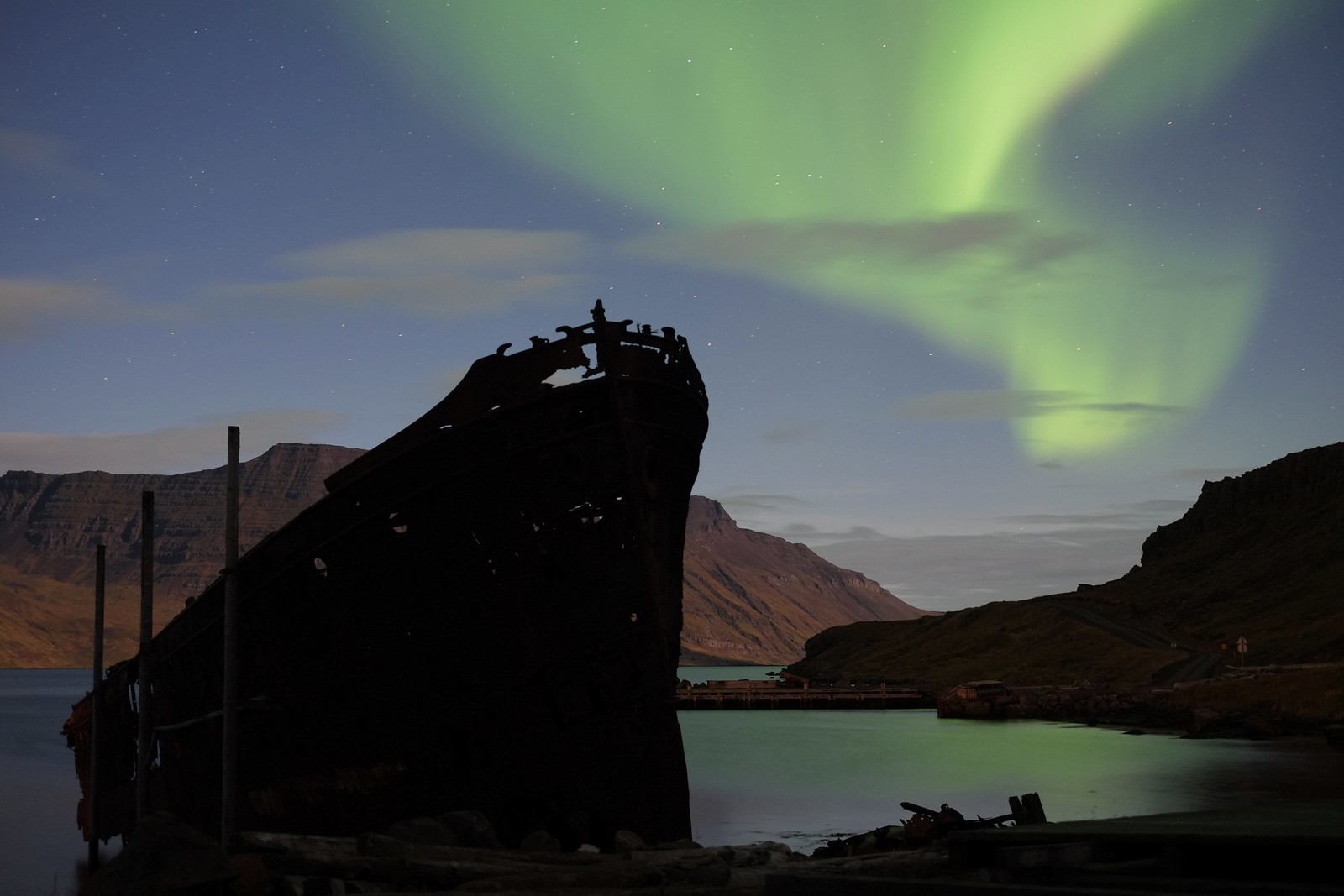
Ship and aurora. Djupavik, Westfjords, Iceland.: photo by efo, 4 October 2017

Ship and aurora. Djupavik, Westfjords, Iceland.: photo by efo, 4 October 2017

Ship and aurora. Djupavik, Westfjords, Iceland.: photo by efo, 4 October 2017
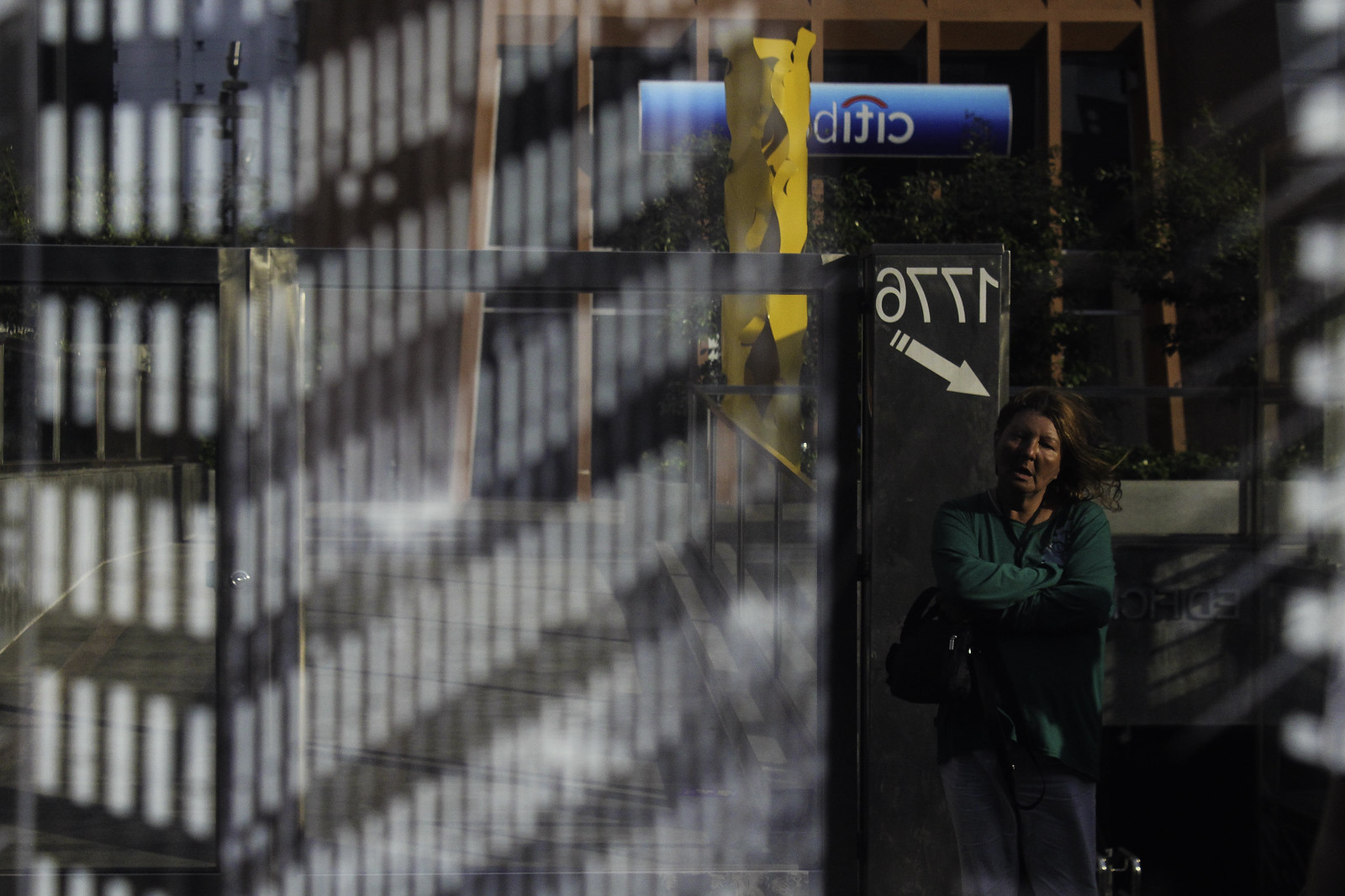
Untitled: photo by Bruno Oliveira, 24 September 2017

Untitled: photo by Bruno Oliveira, 24 September 2017

Untitled: photo by Bruno Oliveira, 24 September 2017
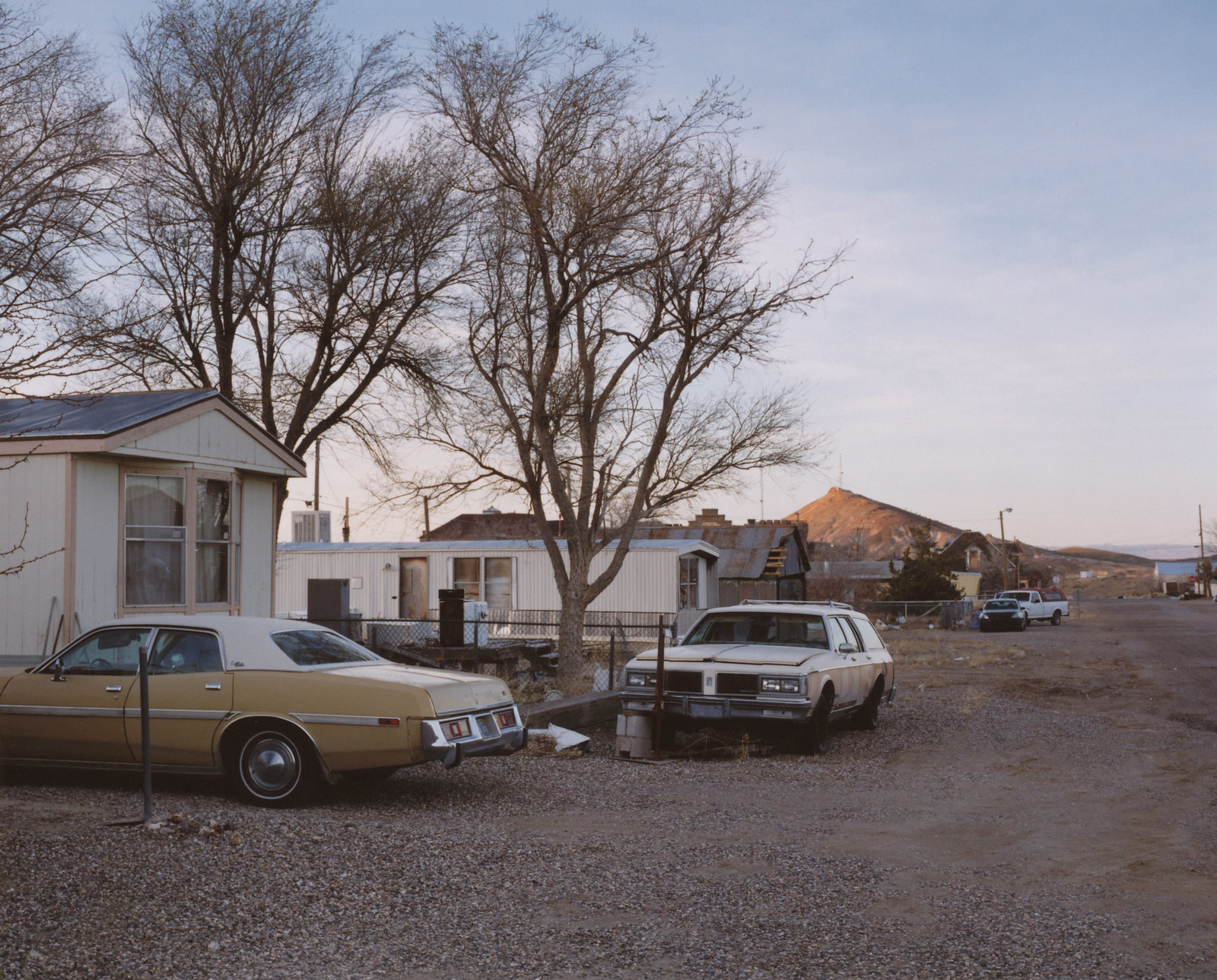
Nevada: photo by Missy Prince, 3 October 2017
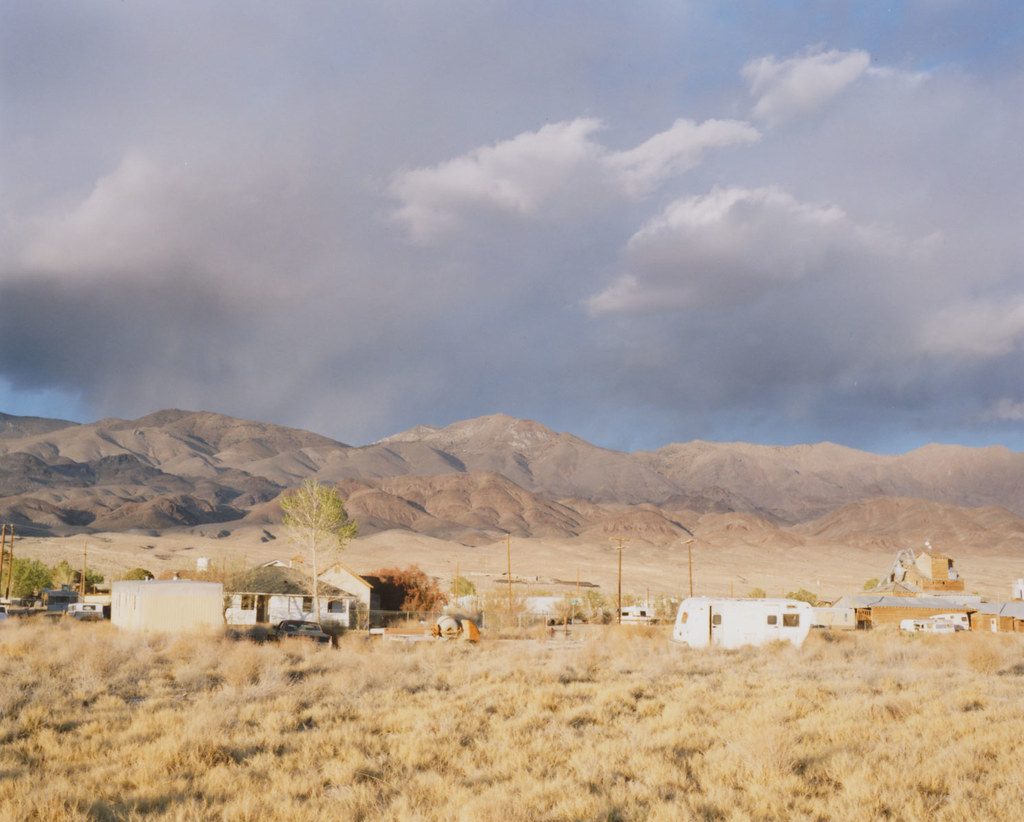
Keeler, California: photo by Missy Prince, 17 May 2017
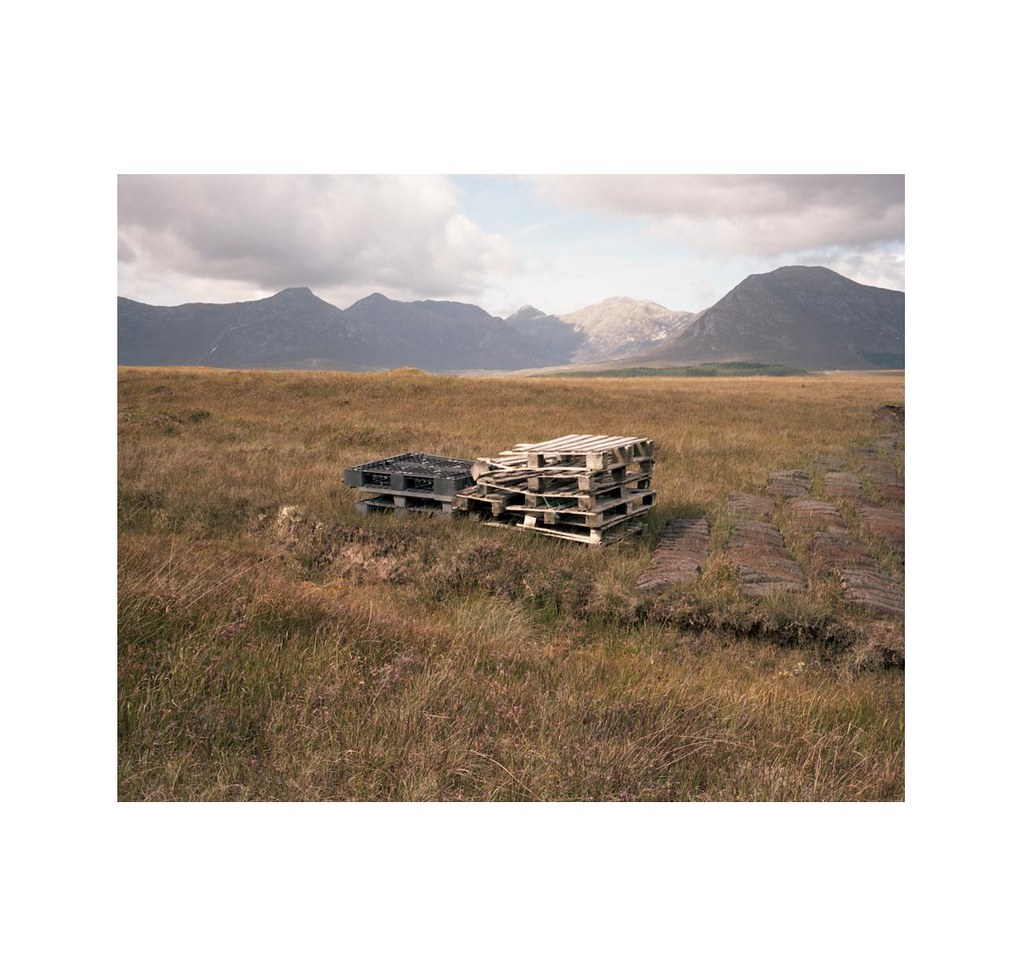
Way out West: photo by StuConFlo, 12 October 2017
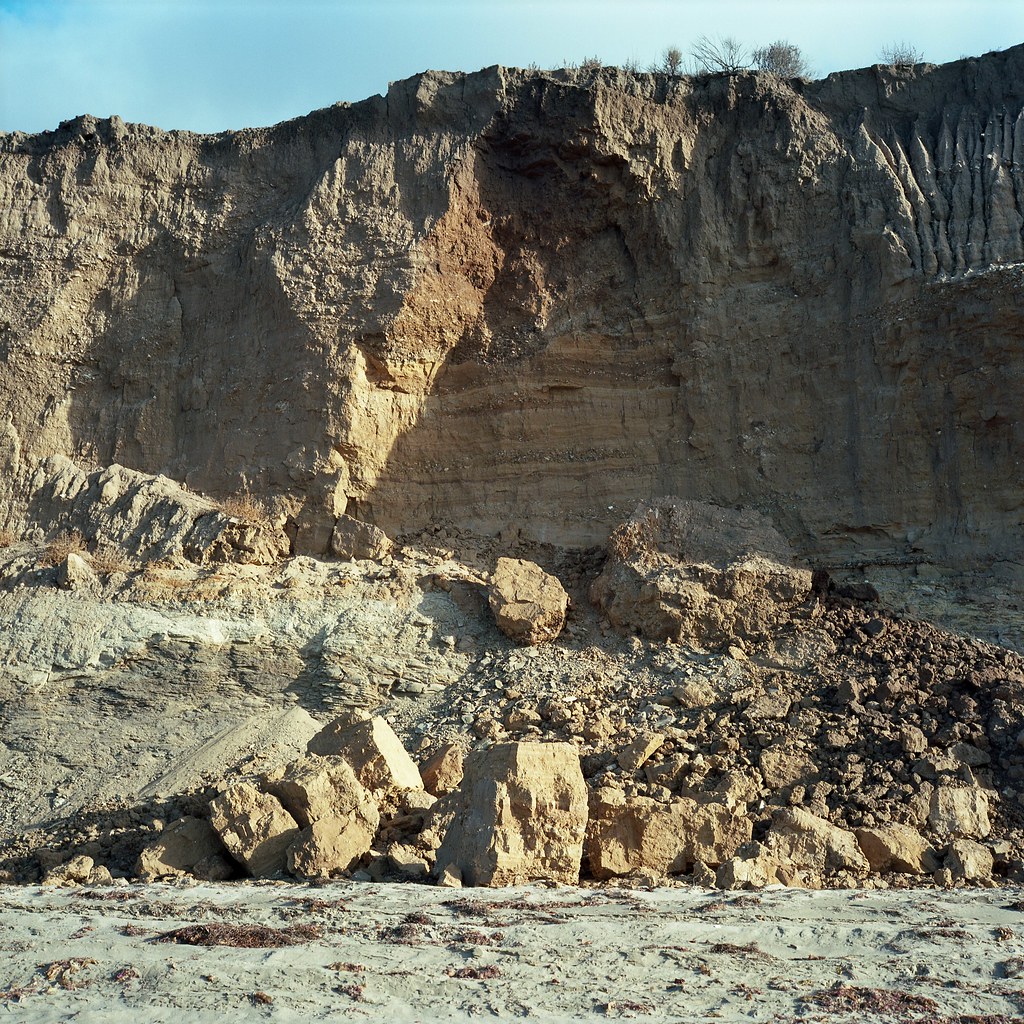
Composition [Santa Barbara County]: photo by Andrew Murr, 11 October 2017
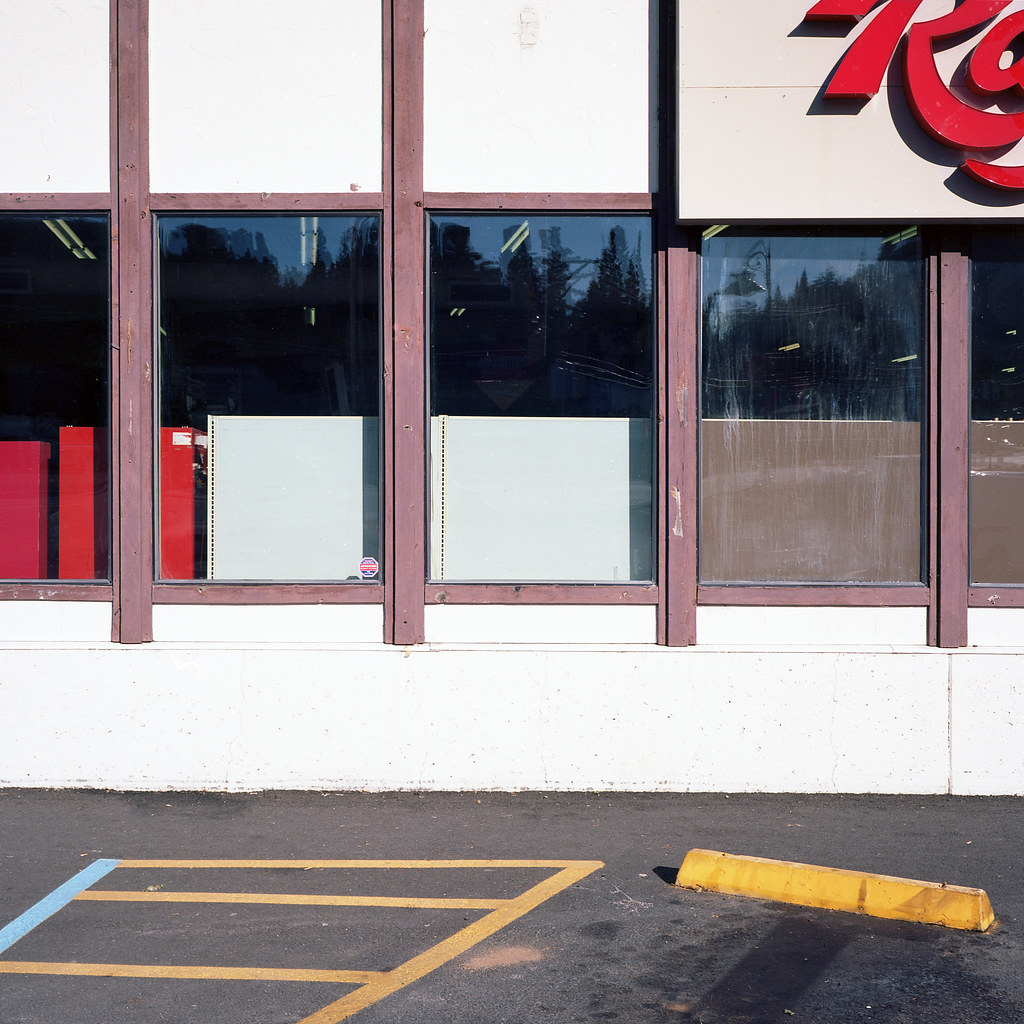
2017-203. Weed, CA: photo by biosfear, 11 October 2017
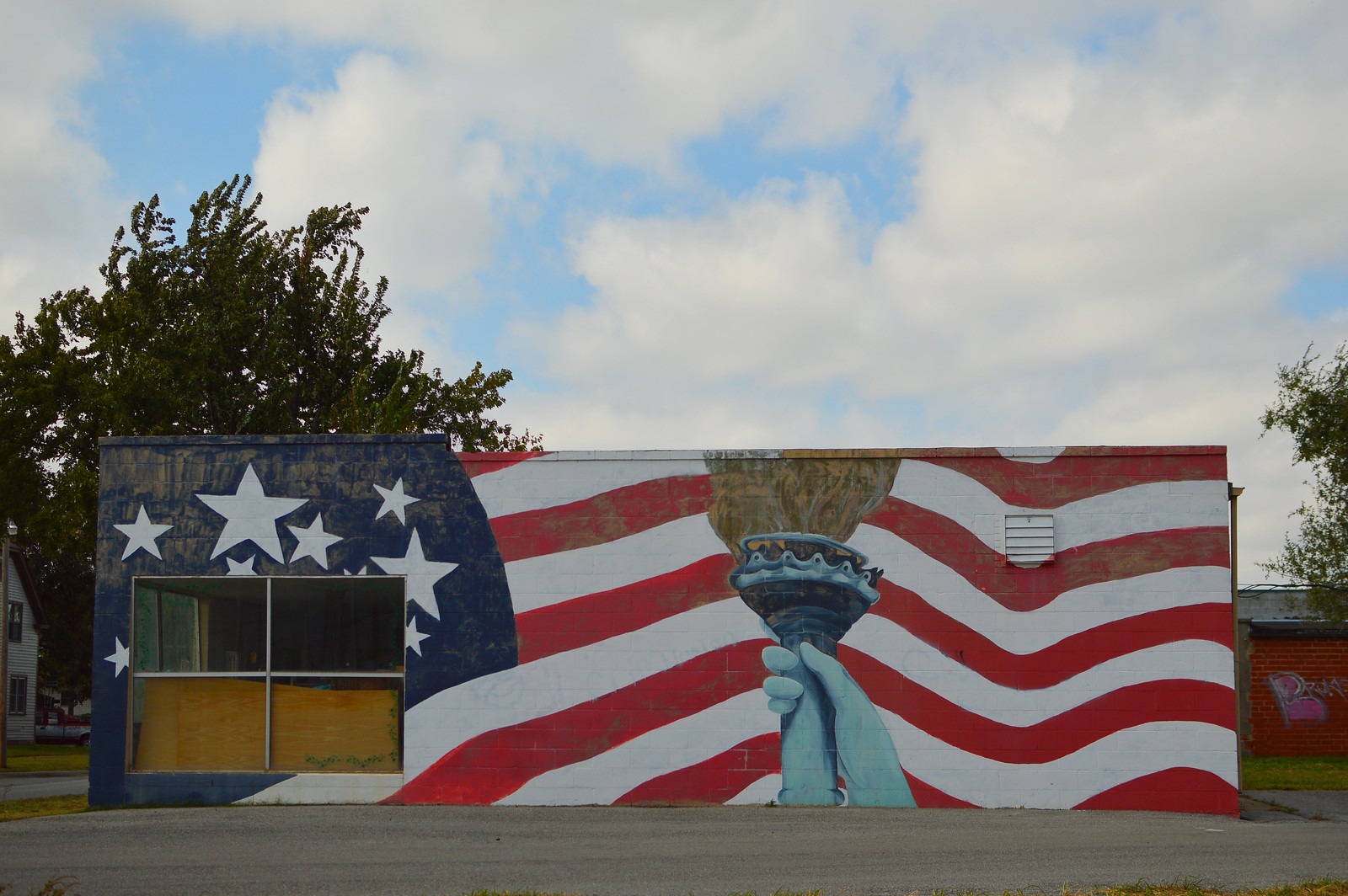
Land of the free [El Reno, OK]: photo by Justin Waits, 15 October 2017

Land of the free [El Reno, OK]: photo by Justin Waits, 15 October 2017

Land of the free [El Reno, OK]: photo by Justin Waits, 15 October 2017
Land of the Free

World Trade Center Towers, New York. In the decade since, most people absorbed 9/11 and moved on, but there are lingering wisps of its effects everywhere.: photo by Katie Day Weisberger, spring 2001 via New York Times International Edition, 11 September 2015
Remembering the events of 9/11 today and always. #remember911: image via gracie schram @gracieschram, 15 September 2015

A digital ad for Delta Air Lines on a bus stop in Lower Manhattan displayed the image of 1 World Trade Center. The building has become a New York City icon -- it is on T-shirts, tchotchkes, hundreds of Instagram feeds and even pizza boxes.: photo by Todd Heisler/The New York Times, 9 September 2016

A digital ad for Delta Air Lines on a bus stop in Lower Manhattan displayed the image of 1 World Trade Center. The building has become a New York City icon -- it is on T-shirts, tchotchkes, hundreds of Instagram feeds and even pizza boxes.: photo by Todd Heisler/The New York Times, 9 September 2016
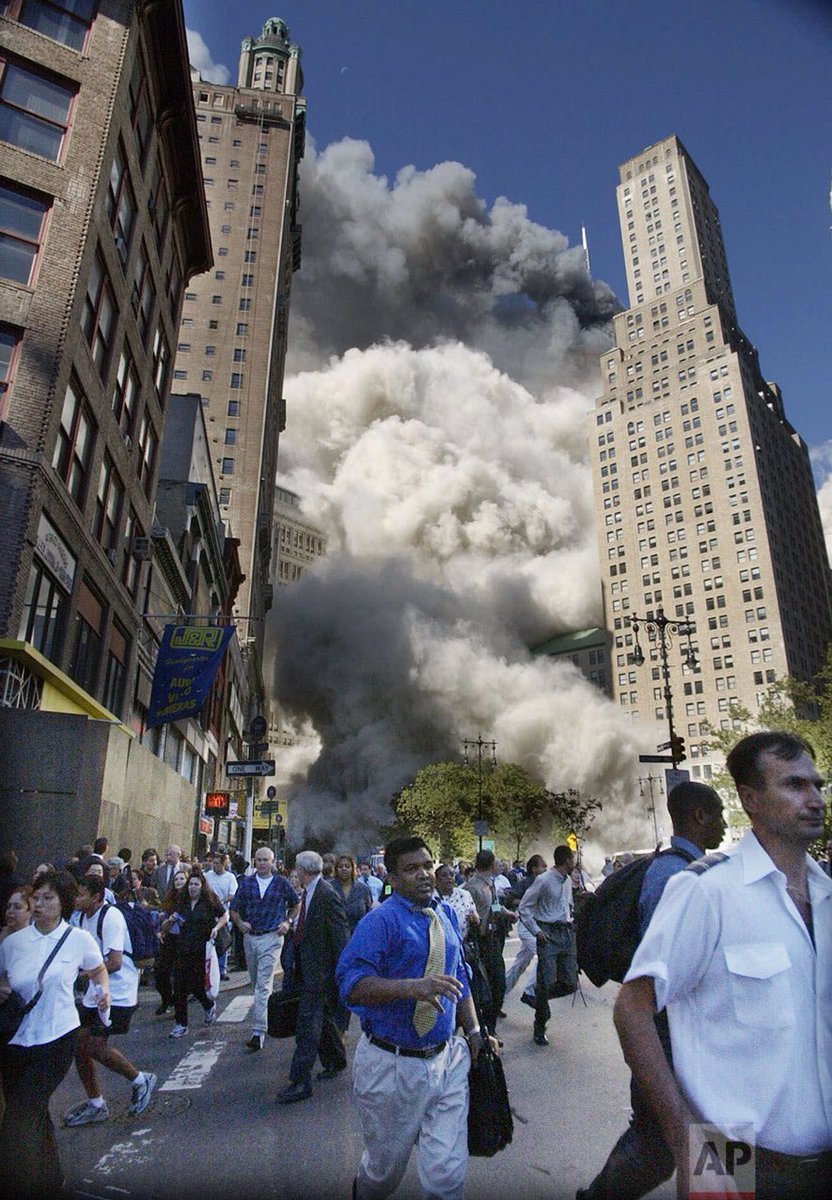
Pedestrians flee the World Trade Center area as the south tower collapses following a terrorist attack OTD in 2001. | Photo @asancetta: image via AP Images @AP_Images, 11 September 2017

Young people on the Brooklyn waterfront on Sept. 11: photo by Thomas Hoepker, 11 September 2001

Lightning strikes on the Bronx viewed from the Empire State Building, New York City: photo by Hermann Luyken, 7 June 2008

7 World Trade Center on fire after the collapse of the Twin Towers, 11 September 2001: photographer anonymous, image by Trycatch, 5 March 2010 (Prints and Photographs Division. Library of Congress)
President George W. Bush reads to children during classroom visit to Emma E. Booker Elementary School, Sarasota, Florida: photographer unknown, 11 September 2001

President George W. Bush is informed by chief of staff Andrew Card of attacks on the World Trade Center during classroom visit to Emma E. Booker Elementary School, Sarasota, Florida: photographer unknown, 11 September 2001
![[Image]](http://ci3.googleusercontent.com/proxy/ch64m6PSgD1jBcJ20OKu-mxZjCBPTonfNqjFHozPAS8cHQtQGQD0i9l7clivBEXWSyi3A5dxM1GS5WEF5SqVP_WnqBQ=s0-d-e1-ft#http://cryptome.org/eyeball/prezsec/pict87.jpg)
A stunned President George W. Bush looks past Chief of Staff Andrew Card after Card told the President about the planes crashing into the World Trade Center in New York City, during Bush's visit to the Emma E. Booker Elementary School in Sarasota, Florida: photo by Doug Mills/Associated Press, 11 September 2001
Edward Sanders: from 9-11, A Poem (2017)
Cheney
Just after 7 a.m.
Just after 7 a.m.
Cheney
sat in v.p.’s
residence at Naval Observatory
for “regular” CIA briefing
Cheney and other administration’s
“sought refuge”
in the
Emergency Operations Center
under the W.H.
Did “anguish”
break upon Cheney’s face
as 9-11 ticked away?
(according to Gordon Johnsdoe
Deputy Press Secretary to the Shrub 2001-2003)
Bush gave a speech
then headed back
into the bunker
Sec Mineta
confirms Cheney
ordered standdown on 9-11 of NORAD orders to shoot down
flight 77 plane headed for Pentagon
8:48-9:05
Trans Sec Norman Mineta
in a breakfast meeting in con room
w/ Belgian trans min
FAA Administrator Jane Garvey
also on hand
Mineta and Garvey
are informed
WTC crash of plane
WH calls tells
Mineta to head for WH
He enters underground bunker ca 9:20
9:03 9-11
Cheney’s mil aide watches the 2nd WTC crash
and goes off to gather the Nuclear Football from the safe in his office
a briefcase that has the necessary codes to
enable the veep to trigger a nuclear attack
He’s Douglas Cochrane
who, with the nuke briefcase
will join Cheney
in the underground tunnel leading to
the Presidential Emergency Operations Center
Transportation Secretary Norman Mineta arrives at WH
9:15
He is told that
Richard Clarke, “counterterrorism tsar”
will have to brief him
In the Situation Room Clarke briefs him 4-5 minutes
He’s told he needs to go to the
Presidential Emergency Operations Center
below the WH
A Sec Serv agent conducts him there
arriving ’tween 9:20-9:27
Mineta meets Cheney in the Bunker
Cheney already there when he arrives
(Questioned in 2007, Mineta said that the vp
was “absolutely… already there”
and that “This was before American Airlines [Flight 77]
went into the Pentagon,” which occurred at 9:37.)
Mineta remembered
in the Bunker
that as a “suspicious” plane flew toward D.C.
a young man entered the Bunker, and said to Cheney,
“The plane is 50 miles out.”
Mineta confers with the Deputy FAA Administrator
at the FAA’s D.C. headquarters, who tells Mineta that the plane’s
transponder’s been shut off, so no identification.
The young man continues to update Cheney,
saying “The plane is 30 miles out,” then finally
“The plane is 10 miles out. Do the orders still stand?”
Cheney, answering, “whipped his neck around and said,
‘Of course the orders still stand. Have you heard anything to the contrary?’”
Mineta thinks that the order being referred to is a shootdown order.
—The accusation is that Cheney deliberately allowed
the plane to crash into the Pentagon
Flight 77 Flies “Complex Near-Circular Loop”
then hits Pentagon
77 does a quick downward spiral, almost a complete circle,
descending in 2 1/2 min 7,000 feet
it’s ca 3.5 miles west-southwest of the Pentagon
altitude ca 7,000 feet
too high to smite the Pentagon
then began a descending turn to the right
after which 77 was at 2,000 feet
and four miles southwest of the Pentagon
The h-jacker sped 77 to around 530 mph
closing in on the Pentagon
77 a Boeing 767
had taken off from Dulles
at 8:10 then at 9:40
struck the Pentagon
killing 64 on the plane
and 125 on the ground
(same morning NRO had scheduled an scenario/exercise
wherein a “small corporate jet”
would crash into one of the four towers
at the NRO headquarters building
Chantilly, Va ca 4 miles
from Dulles airport)
p. 11 Ruppert, Crossing the Rubicon
Deirdre called Woodstock
from Massachusetts
just after 9
and suggested I turn on the television
Soon I went into our bedroom
and awakened Miriam
“I think our country is under attack”
Shortly later I drove downtown
to fill our gas tank
thinking I’d be the only one
wary of having to flee an attack
but there were a good number in line waiting
On Sept. 11, 2001, WTC 1 and WTC 2
were struck 16 minutes apart by Boeing 767-200ER aircraft.
WTC 1 was hit at 8:46 a.m. by American Airlines Flight 11,
and WTC 2 was hit at 9:02 a.m. by United Airlines Flight 175.
WTC 2 collapsed at 9:58 a.m.
and WTC 1 at 10:28 a.m.
WTC Building 7
9:03
Building 7 was evacuated just after 9
The Secret Service’s NY Field Office
was in Building 7
—Sec Serv kept a secret Stinger missile
in the WTC
to protect the President
in case of an attack when he visited NYC
WTC 7 collapsed 5:20 p.m. 9-11
WTC 7 collapsed 5:20 p.m. 9-11
“WTC 7 endured fires for almost seven hours,
from the time of the collapse of the north WTC tower (WTC 1)
at 10:28:22 a.m. until 5:20:52 p.m.,
when WTC 7 collapsed.”
Disrupted Communications 9-11
Telephone and cellphone service
around DC
unavailable most of 9-11 day
(just as it reportedly was on 11-22-63)
and also the public in NYC
suffered prob’s w/ communications
in the day of 9-11
esp cellphones
WTC Building 7 Evacuated
9:03 a.m.
A soldier at the scene claimed that
WTC Building 7
was evacuated before second tower was struck
of course there had already been a self-evacuation
After the first attack all Secret Service field WTC 7 office
personnel had been told to leave
NYC Workers Hear Explosions in WTC 7
(’Tween 9:15 and Noon)
Two workers, one for the City Housing Authority
and the other, NY’s corporation counsel,
heard “unexplained explosions” within
WTC 7, where they grew trapped
They had gone up to the Emergency Command Center
on the 23rd floor after the first tower was struck
The power went out, and both started down the stairs
to escape, but when they reached the 8th floor
there was an explosion, with thick smoke all about
and they were trapped for an hour and one half.
There were explosions, when one reached the 6th floor,
the explosions beneath where he was
Then they went back to the 8th floor. One of them said,
“I heard some more explosions. This is it. We’re dead.
We’re not going to make it out of here.”
One of them tells the London Independent
that both of the Twin Towers were still standing
when the explosions began
and when they headed down the WTC 7 stairs
to escape
Controlled Demolition of the 47-Story WTC 7
Controlled Demolition of the 47-Story WTC 7
The National Institute of Standards and Technology (NIST)
issued a report blaming
a thermal expansion of floor beams pushed an adjoining girder
off its seat, which led to a subsequent collapse
of eight floors. An additional failure
of other girders from the same thermal expansion
caused a nine-story column to collapse,
followed by the collapse of the rest of the interior
and then the exterior.
A researcher named Steven Jones pointed out that, based
on video evidence of the fall, that the building, upon collapse,
went into free fall, suggesting a controlled demolition
Thermite was found in the WTC collapse dust
“Thermite is a powdered amalgam of iron oxide and other alloys
that can be described as the metal equivalent to kindling.
This powder works as an ignitor generating extremely high temperatures.
Nano-thermite is a more highly advanced version developed by the military
for its customizable reaction rates and incredibly small particulate size.
“It releases energy much quicker than regular thermite
and can be ignited by unconventional means
such as laser pulses
A stream of molten metal was also recorded pouring
out of the towers before they collapsed,
an indication of nano-thermite at work.
More than $100 Million Pulled
from WTC on 9-11
Data recovery experts later looking at 32 hard drives
salvaged from the 9/11 attacks discover a surge in credit card transactions
from the World Trade Center in the hours before and during
the attacks.
Unusually large sums of money are rushed through computers
even as the disaster unfolds. Investigators later say:
“There is a suspicion that some people had advance knowledge
of the approximate time of the plane crashes
in order to move out amounts exceeding
$100 million.
They thought that the records of their transactions could not be traced
after the mainframes were destroyed.”
The data recovery effort is led by the German company Convar.
Convar will not disclose the identity of its clients.
Bush arrived in the Bunker
just before 7 p.m.
Cheney arose
to speak with him
motioning with his hands
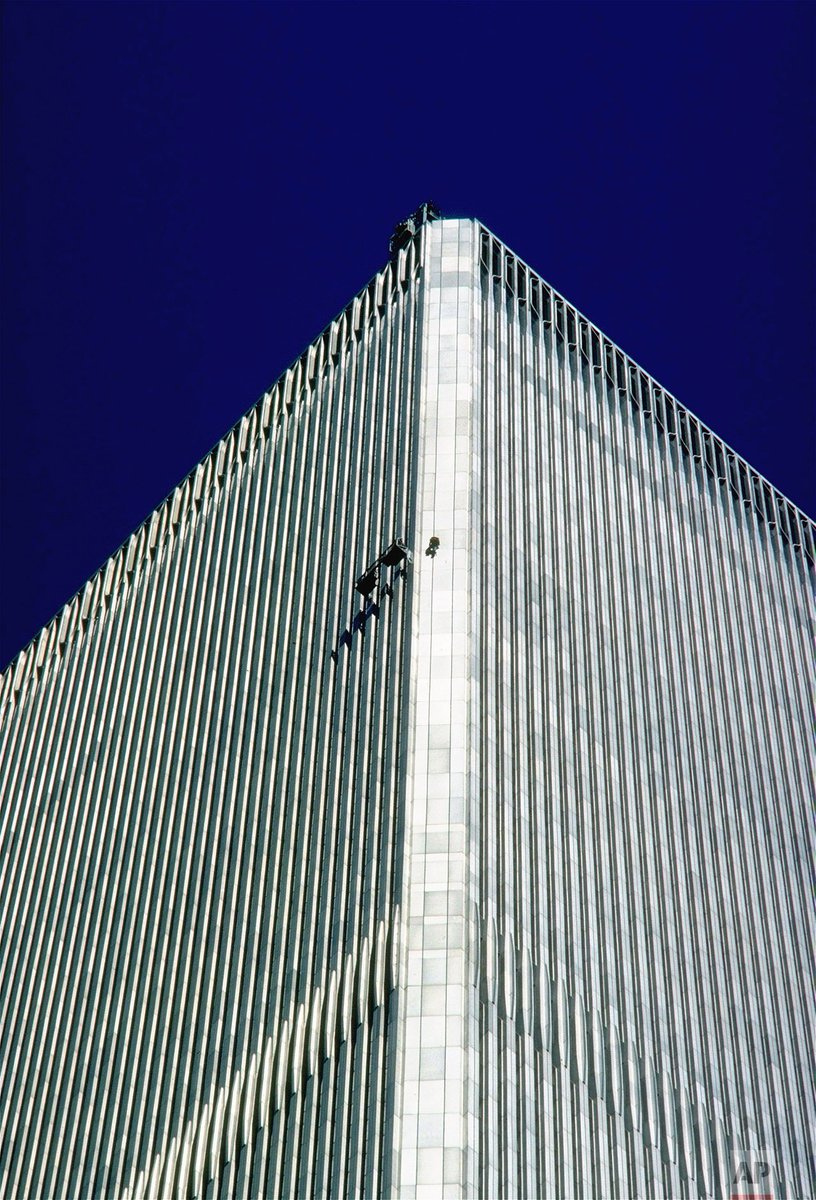
#OTD 40 years ago, George Willig scaled the outside of the South Tower of New York's World Trade Center.: image via AP Images @AP_Images, 25 May 2017
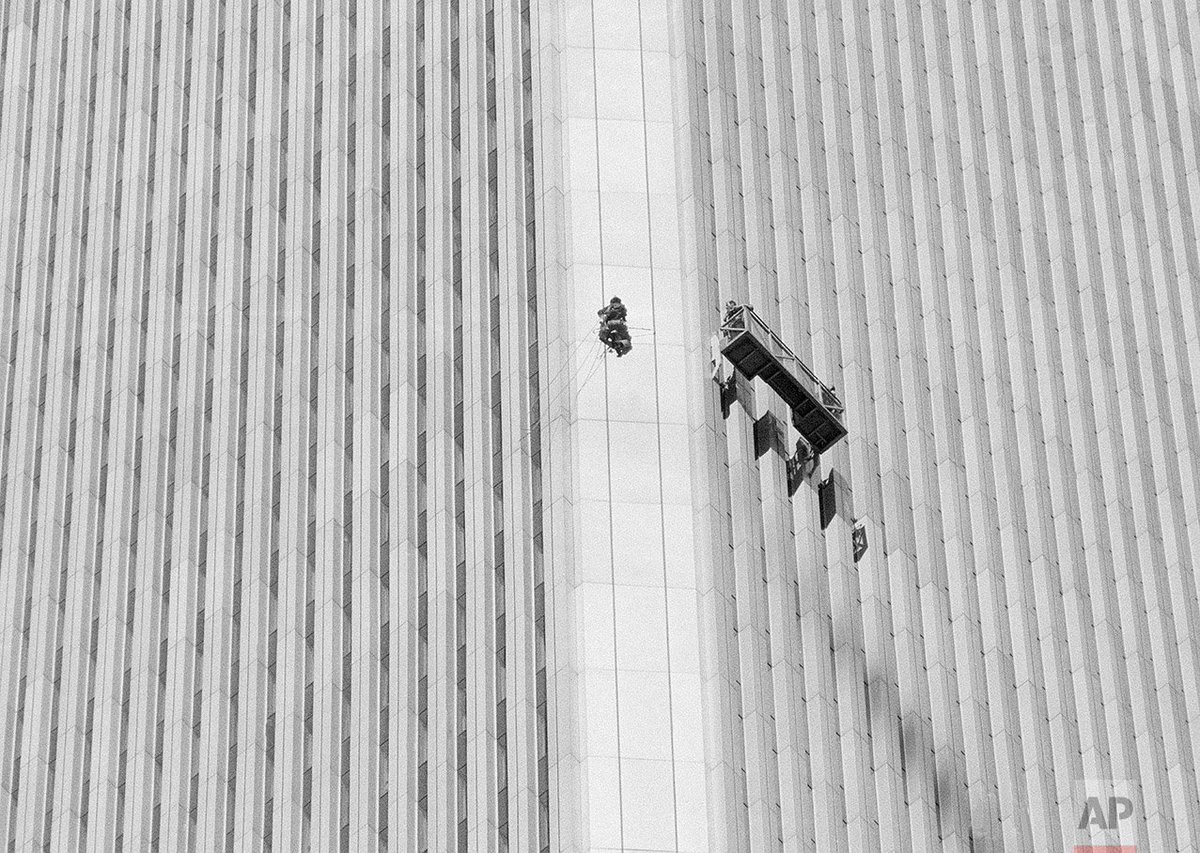
#OTD 40 years ago, George Willig scaled the outside of the South Tower of New York's World Trade Center.: image via AP Images @AP_Images, 25 May 2017

#OTD 40 years ago, George Willig scaled the outside of the South Tower of New York's World Trade Center.: image via AP Images @AP_Images, 25 May 2017
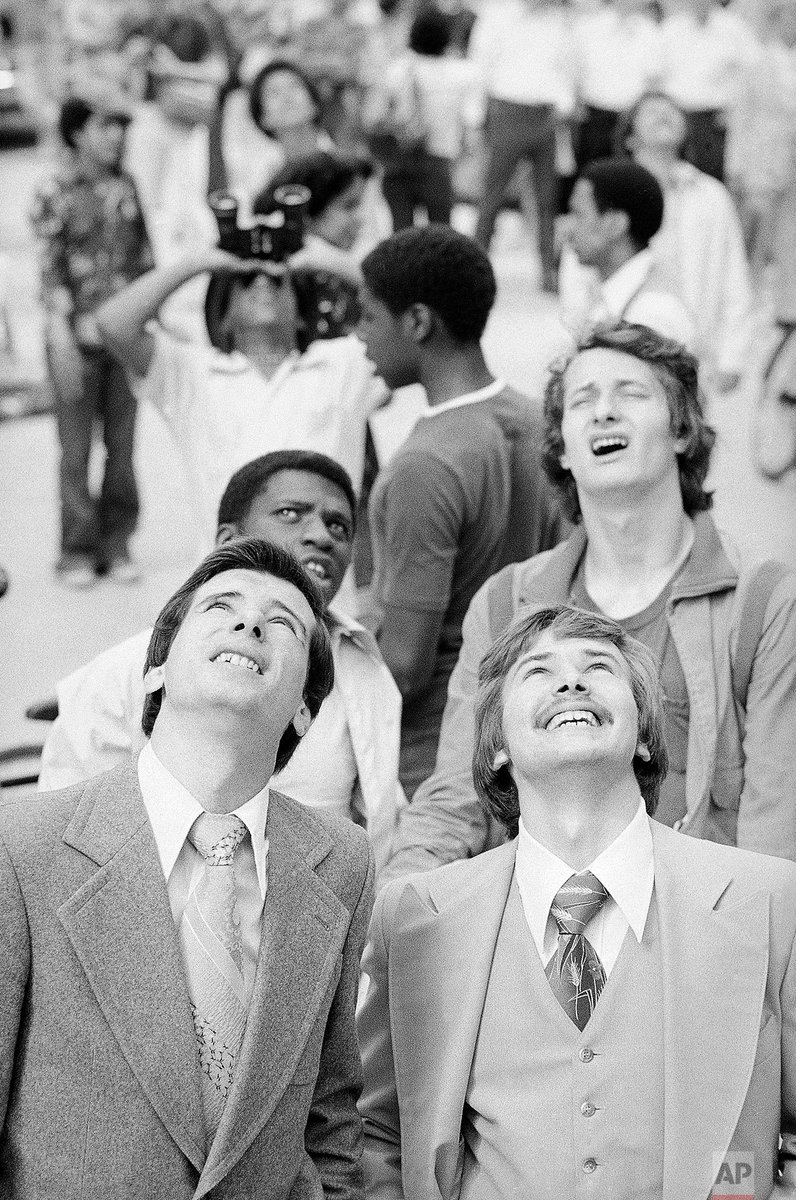
#OTD 40 years ago, George Willig scaled the outside of the South Tower of New York's World Trade Center.: image via AP Images @AP_Images, 25 May 2017

The view from a hoist at 3 World Trade Center on Wednesday: photo by George Etheredge/The New York Times, 31 August 2016
![]()
I like the call and response style the poem uses right after it sets up the contrasting opening lines, “grey exurban wasteland” and “once happy valley”. The poem goes well with the title of this book -- Light and Shade (which in turn evokes Keats).
-- Black Mamba, in (pō‘ĭ-trē), 26 April 2006
![File:Happy-valley-entrance-tn1.jpg]()
![New-Orleans post Katrina Sept 2005: muddy car of the hurricane | by Gilbert Mercier]()
New Orleans post-Katrina Sept 2005: muddy car of the hurricane. Dry mud left by the flood inside a car in Midtown. Thousands of cars, trucks and school buses were lost to the flood.: photo by Gilbert Mercier, 4 September 2005
What a beautiful writer Fitzgerald is. It’s a road between worlds. Between the world of leisure, dreams and consumption -- Daisy’s world -- and the world of iron mills, stock markets, production -- Gatsby’s world. The main line of late capitalism in its full traffic. Things are just beginning to go to rot, so the society has to go a little out of its way so as not to look at its own corruption, the ashes that have begun to accumulate at the margins of its dream, like an off-taste in its mouth that needs washing down and away with a good stiff drink, and maybe then another one.
I had that passage in mind when I started the poem: “As in that grey exurban wasteland in Gatsby / When the white sky darkens over the city / Of ashes, far from the once happy valley, / This daze spreads across the blank faces / Of the inhabitants, suddenly deprived / Of the kingdom’s original promised gift.” With “happy valley,” I was thinking, perhaps, of the America of Johnny Appleseed, in the Disney version, bright and abundant fields and orchards, that cartoon dream of an American past supplanting the endarkened vision of the present and future which Fitzgerald saw, or vice versa, the two perhaps colliding, vision and dream, at the post-9/11 moment when the inhabitants are suddenly and abruptly forced to see the shadow of a possible ash-gray cloud descending over their erstwhile bright world. The poem was written in that interesting early Fall of 2001, just after 9/11 and during the subsequent anthrax terror scare. You gaped with wonder at the TV where white-lipped network newscasters grimly presented footage of Hazmat teams in yellow plastic suits swarming pointlessly around outside suspected toxic terror sites -- the parking lots of drab office blocks, suburban school buildings, gray hospitals. It made you think of gangs of lost, bumbling astronauts who’ve landed on the wrong planet and aren’t quite sure what to do next. Meanwhile crowds of evacuated workplace normals could be seen apprehensively looking on, too sheepish to acknowledge the real terrorists might be those they’d chosen to govern them. That image of the doubled wastelands, the wasteland in Gatsby, the wasteland in the suburban office building parking lot, was indeed, as you’ve said, the switch that opened the floodgates of the “call and response” structure that holds the poem together, even as it tries to fall apart.
![File:WTC-crash.jpg]()
WTC crash: photo by Kevinalbania, 11 September 2001
![File:World Trade Center collapse - West Broadway.jpg]()
Einsturz WorldTradeCenter 2 gesehen vom West Broadway (Collapse of WorldTradeCenter 2): photo by Hans Joachim Dudeck, 11 September 2001; image 21 June 2009
![File:LOC unattributed Ground Zero photos, September 11, 2001 - item 064.jpg]()
The corner of Greenwich and Barclay, facing East, near the destroyed WorldTradeCenter on 9/11/2001: photographer anonymous, 11 September 2001 (Prints and Photographs Division. Library of Congress)
![File:September11AttacksByLuigiNovi4.jpg]()
Onlookers viewing the immediate aftermath of the 9/11 Attacks on September 11, 2001, in Doric Park in Union City, New Jersey. The location was rebuilt as Firefighter's Memorial Park, which opened on August 8, 2009. The buildings of Hoboken are visible between the background of Manhattan and the foreground of the Park. Doric Park was later turned into Firefighter's Memorial Park, which opened on August 8, 2009: photo © by Luigi Novi / Wikimedia Commons, 11 September 2001
![File:911 New York City Views, 09-11-2001.jpg]()
Smoke rises from the site of the WorldTradeCenter Tuesday, September 11, 2001: photo by White House Office of Management and Administration (Photographs related to the George W. Bush Administration, George W. Bush Library, Lewisville, Texas / US National Archives)
![]()
Untitled [Young people on the Brooklyn waterfront on September 11]: photo by Thomas Hoepker / Magnum Photos, 11 September 2001
![]()
Untitled [Young people on the Brooklyn waterfront on September 11]: photo by Thomas Hoepker / Magnum Photos, 11 September 2001
Hazard Response
As in that grey exurban wasteland in Gatsby
When the white sky darkens over the city
Of ashes, far from the once happy valley,
This daze spreads across the blank faces
Of the inhabitants, suddenly deprived
Of the kingdom’s original promised gift.
Did I say kingdom when I meant place
Of worship? Original when I meant
Damaged in handling? Promised when
I meant stolen? Gift when I meant
Trick? Inhabitants when I meant slaves?
Slaves when I meant clowns
Who have wandered into test sites? Test
Sites when I meant contagious hospitals?
Contagious hospitals when I meant clouds
Of laughing gas? Laughing gas
When I meant tears? No, it’s true,
No one should be writing poetry
In times like these, Dear Reader,
I don’t have to tell you of all people why.
It’s as apparent as an attempted
Punch in the eye that actually
Catches only empty air -- which is
The inside of your head, where
The green ritual sanction
Of the poem has been cancelled.TC: Hazard Response, 2001, from Light and Shade, 2006

So She Moved into the Light: Eric Fischl, 1997
Black Mamba: On Hazard Response
I like the call and response style the poem uses right after it sets up the contrasting opening lines, “grey exurban wasteland” and “once happy valley”. The poem goes well with the title of this book -- Light and Shade (which in turn evokes Keats).
Here is a bit from a conversation featured in Jacket's April ’06 issue, where Clark talks about this poem:
“I had that passage [from The Great Gatsby] in mind when I started the poem: ….
"With 'happy valley,' I was thinking, I guess, of the America of Johnny Appleseed, in the Disney version, bright and abundant fields and orchards, that cartoon dream of an American past supplanting the endarkened vision of the present and future which Fitzgerald saw, or vice versa…
"The poem was written in that interesting early Fall of 2001, just after 9/11 and during the subsequent anthrax terror scare. One gaped with wonder at the TV while white-lipped network newscasters grimly presented footage of Hazmat teams in yellow plastic suits swarming pointlessly around outside suspected toxic terror sites…
"Meanwhile crowds of evacuated workplace normals could be seen apprehensively looking on, too sheepish to acknowledge the real terrorists might be those they’d chosen to govern them. That image of the doubled wastelands, the wasteland in Gatsby, the wasteland in the suburban office building parking lot, was indeed, as you’ve said, the switch that opened the floodgates of the 'call and response' structure that holds the poem together, even as it tries to fall apart.”
-- Black Mamba, in (pō‘ĭ-trē), 26 April 2006

Entrance to Happy Valley, Tennessee: photo by Brian Stansberry, 2008
Hazard Response: The White Sky Darkens over the City of Ashes (from a conversation)
Ryan Newton: I believe “Hazard Response” was written not too long after the fateful events around 9/11. Your admiration for Fitzgerald’s classic Gatsby is as pertinent as Fizgerald’s own ardour for the works of John Keats (especially “Ode on a Grecian Urn,” as you point out in your lectures on Keats), who is evoked in the title Light and Shade, your forthcoming book. How does the opening image of the “grey exurban wasteland” feature in opening the floodgates of call and response in this poem, which seems to be arranged on a suddenly active faultline?
TC: Yes, the title Light and Shade remembers Keats, who, in a letter written as he was dying, told a friend he could no longer write poetry because it took too much out of him -- to write poetry, he was saying, requires a tremendous effort, the struggle to set up its contrastive bases, to discriminate“light and shade,” the “primitive information,” and he no longer had that kind of energy. I can understand that. As to Fitzgerald -- who probably owed as much to Keats as one writer can owe to another -- there’s a beautiful letter to his daughter in which he recounts reading the “Ode on a Grecian Urn” a hundred times before beginning to sort out the exquisite mechanics, the inner chime -- yes, the poem “Hazard Response” begins with a deliberate reference to his work. His early prophetic vision of a wasted post-industrial America was very much in my mind. I was thinking specifically of the opening of the second chapter of The Great Gatsby in which he describes a stretch of road on Long Island, about half way between West Egg and New York, where the highway seems to shrink away from a certain desolate area of land. “This is a valley of ashes -- a fantastic farm where ashes grow like wheat into ridges and hills and grotesque gardens; where ashes take the forms of houses and chimneys and rising smoke and, finally, with a transcendent effort, of men who move dimly and already crumbling through the powdery air.” The ash-covered men are railway workmen, but they are also mysterious symbolic men. “Occasionally a line of gray cars crawls along an invisible track, gives out a ghastly creak, and comes to rest, and immediately the ash-gray men swarm up with leaden spades and stir up an impenetrable cloud, which screens their obscure operations from your sight.” Just what is it those surreptitious men are doing, in that ash-gray cloud?
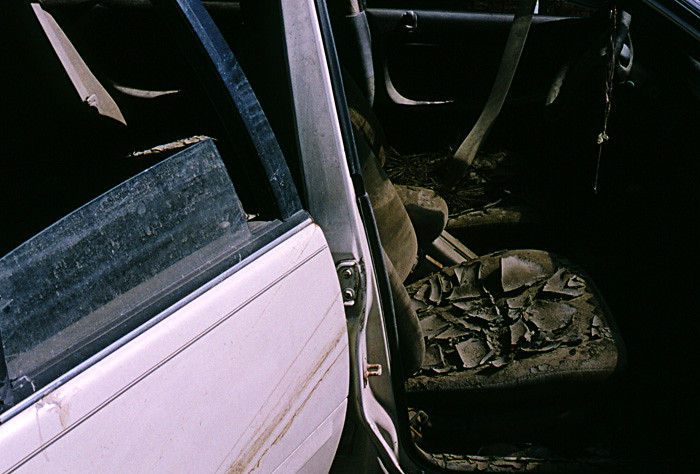
New Orleans post-Katrina Sept 2005: muddy car of the hurricane. Dry mud left by the flood inside a car in Midtown. Thousands of cars, trucks and school buses were lost to the flood.: photo by Gilbert Mercier, 4 September 2005
What a beautiful writer Fitzgerald is. It’s a road between worlds. Between the world of leisure, dreams and consumption -- Daisy’s world -- and the world of iron mills, stock markets, production -- Gatsby’s world. The main line of late capitalism in its full traffic. Things are just beginning to go to rot, so the society has to go a little out of its way so as not to look at its own corruption, the ashes that have begun to accumulate at the margins of its dream, like an off-taste in its mouth that needs washing down and away with a good stiff drink, and maybe then another one.
I had that passage in mind when I started the poem: “As in that grey exurban wasteland in Gatsby / When the white sky darkens over the city / Of ashes, far from the once happy valley, / This daze spreads across the blank faces / Of the inhabitants, suddenly deprived / Of the kingdom’s original promised gift.” With “happy valley,” I was thinking, perhaps, of the America of Johnny Appleseed, in the Disney version, bright and abundant fields and orchards, that cartoon dream of an American past supplanting the endarkened vision of the present and future which Fitzgerald saw, or vice versa, the two perhaps colliding, vision and dream, at the post-9/11 moment when the inhabitants are suddenly and abruptly forced to see the shadow of a possible ash-gray cloud descending over their erstwhile bright world. The poem was written in that interesting early Fall of 2001, just after 9/11 and during the subsequent anthrax terror scare. You gaped with wonder at the TV where white-lipped network newscasters grimly presented footage of Hazmat teams in yellow plastic suits swarming pointlessly around outside suspected toxic terror sites -- the parking lots of drab office blocks, suburban school buildings, gray hospitals. It made you think of gangs of lost, bumbling astronauts who’ve landed on the wrong planet and aren’t quite sure what to do next. Meanwhile crowds of evacuated workplace normals could be seen apprehensively looking on, too sheepish to acknowledge the real terrorists might be those they’d chosen to govern them. That image of the doubled wastelands, the wasteland in Gatsby, the wasteland in the suburban office building parking lot, was indeed, as you’ve said, the switch that opened the floodgates of the “call and response” structure that holds the poem together, even as it tries to fall apart.
RN: If the poem is about the apocalyptic disintegration of the founding illusions surrounding “the kingdom’s original promised gift,” what is your role in this process as a sometime citizen of the United States? After all, one cannot help noticing that you are engaging in a series of spiralling questions directed at your own assumptions. Are you allowing that your own subject-engagement with the perceived shift in historical epoch be counted among the other “inhabitants”?
TC: Absolutely. The “call and response” -- the self-corrective, interrogative series that follows the wasteland image -- actually turns the argument of the poem over to the reader to play with and sort out. It’s definitely a kind of confession of being at a loss along with the reader. That’s what takes the poem over the falls, that identification with a common nescience. It scares me every time I read it.
from Tom Clark in conversation with Ryan Newton, in Jacket 29 (April 2006)

WTC crash: photo by Kevinalbania, 11 September 2001

Einsturz WorldTradeCenter 2 gesehen vom West Broadway (Collapse of WorldTradeCenter 2): photo by Hans Joachim Dudeck, 11 September 2001; image 21 June 2009

The corner of Greenwich and Barclay, facing East, near the destroyed WorldTradeCenter on 9/11/2001: photographer anonymous, 11 September 2001 (Prints and Photographs Division. Library of Congress)

Onlookers viewing the immediate aftermath of the 9/11 Attacks on September 11, 2001, in Doric Park in Union City, New Jersey. The location was rebuilt as Firefighter's Memorial Park, which opened on August 8, 2009. The buildings of Hoboken are visible between the background of Manhattan and the foreground of the Park. Doric Park was later turned into Firefighter's Memorial Park, which opened on August 8, 2009: photo © by Luigi Novi / Wikimedia Commons, 11 September 2001

Smoke rises from the site of the WorldTradeCenter Tuesday, September 11, 2001: photo by White House Office of Management and Administration (Photographs related to the George W. Bush Administration, George W. Bush Library, Lewisville, Texas / US National Archives)
Thomas Hoepker: The Day the Sun Went Down on Happy Valley

Untitled [Young people on the Brooklyn waterfront on September 11]: photo by Thomas Hoepker / Magnum Photos, 11 September 2001
Now that a broad discussion has opened up about a photograph that I took on September 11, 2001, on the waterfront in Brooklyn, I think I should add my voice and view of the event.
This image happened, in passing, so to speak, when I tried to make my way down to southern Manhattan on the morning of 9/11. I live on the Upper East Side of Manhattan and, being a seasoned photojournalist, I followed my professional instinct, trying hard to get as close as possible to the horrendous event. When I heard that the subway had stopped running I took out the car, only to get stuck immediately in traffic on Second Avenue. I took my chances by crossing the Queensborough Bridge. Then, turning south into Queens and Brooklyn, I stayed close to the East River, stopping here and there to shoot views of the distant catastrophe, which unfolded on the horizon to my right. The car radio provided horrific news, nonstop. The second tower of the WorldTradeCenter had just imploded; estimates of more than 20,000 deaths were quoted and later discredited.
Untitled [Young people on the Brooklyn waterfront on September 11]: photo by Thomas Hoepker / Magnum Photos, 11 September 2001
Somewhere in Williamsburg I saw, out of the corner of my eye, an almost idyllic scene near a restaurant -- flowers, cypress trees, a group of young people sitting in the bright sunshine of this splendid late summer day while the dark, thick plume of smoke was rising in the background. I got out of the car, shot three frames of the seemingly peaceful setting and drove on hastily, hoping/fearing to get closer to the unimaginable horrors at the tip of Manhattan.
from I Took That 9/11 Photo: Thomas Hoepker, Slate, 14 September 2006
![#13 | by Md. Imam Hasan]()
#13 [Dhaka]: photo by Muhammad Imam Hasan, 30 August 2016
![liberty | by clairebrinberg]()
liberty[NY Fashion Week]: photo by Claire Brinberg, 10 September 2017
![liberty | by clairebrinberg]()
liberty [NY Fashion Week]: photo by Claire Brinberg, 10 September 2017
![liberty | by clairebrinberg]()
liberty [NY Fashion Week]: photo by Claire Brinberg, 10 September 2017
from I Took That 9/11 Photo: Thomas Hoepker, Slate, 14 September 2006

#13 [Dhaka]: photo by Muhammad Imam Hasan, 30 August 2016
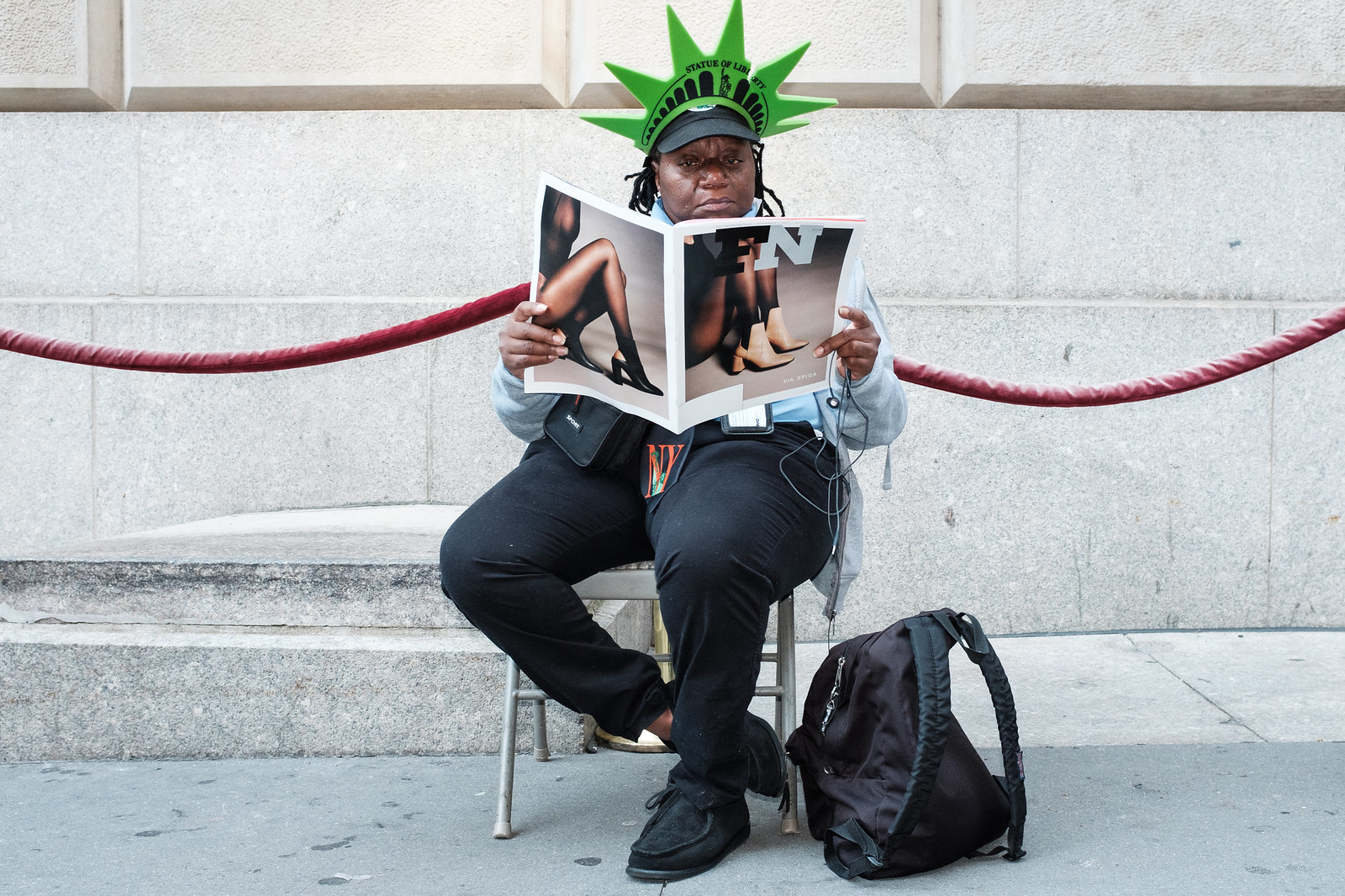
liberty[NY Fashion Week]: photo by Claire Brinberg, 10 September 2017

liberty [NY Fashion Week]: photo by Claire Brinberg, 10 September 2017

liberty [NY Fashion Week]: photo by Claire Brinberg, 10 September 2017




